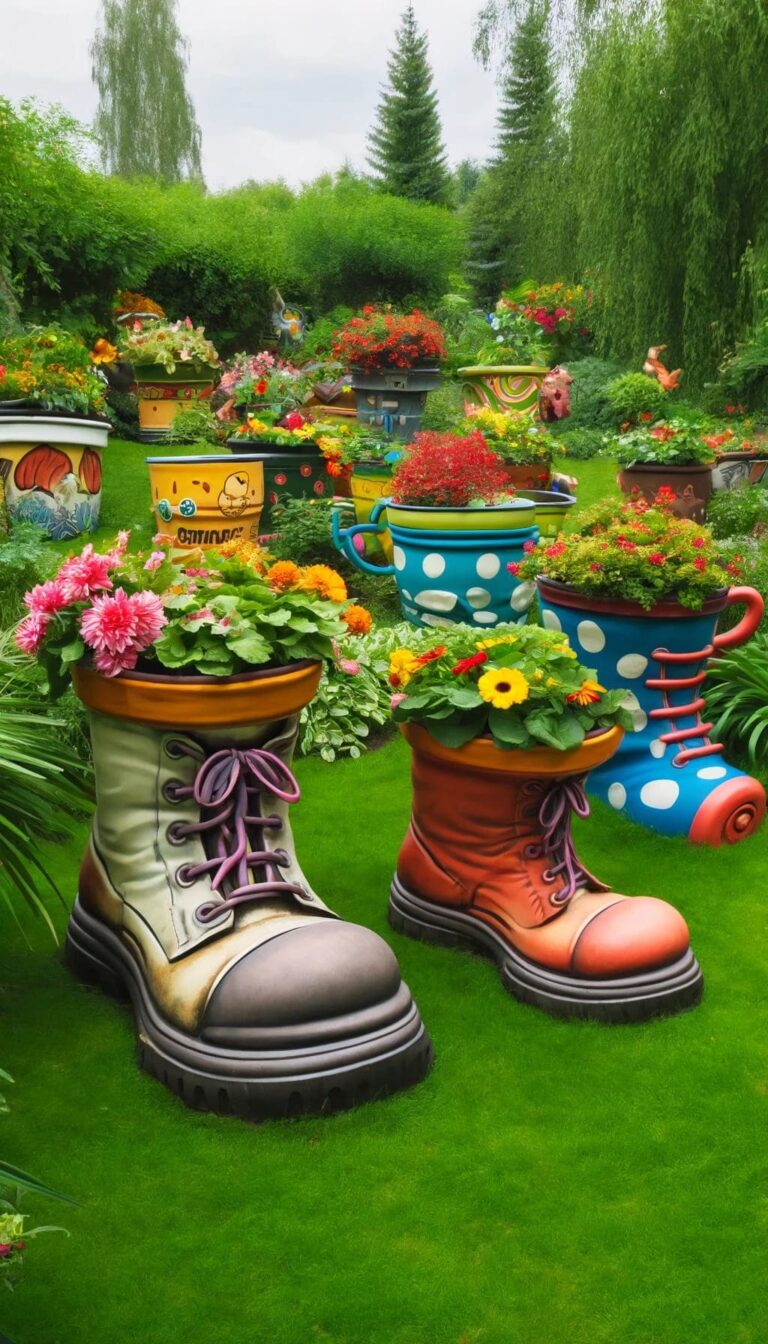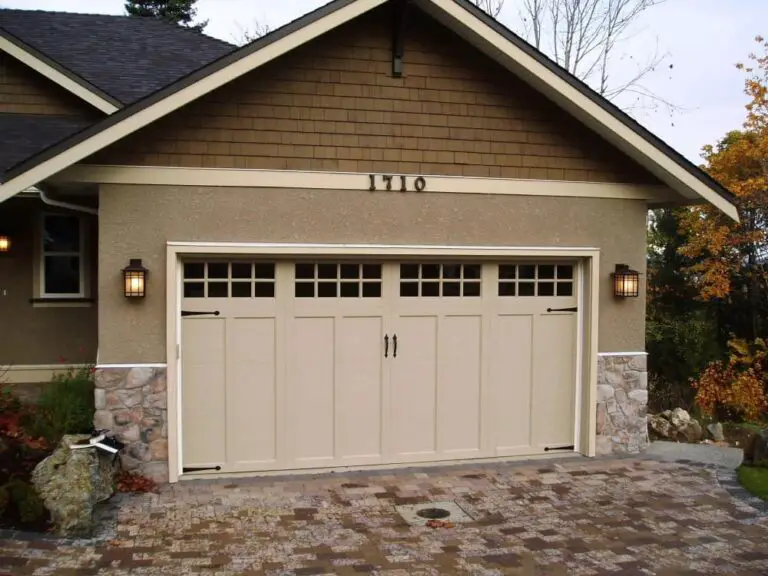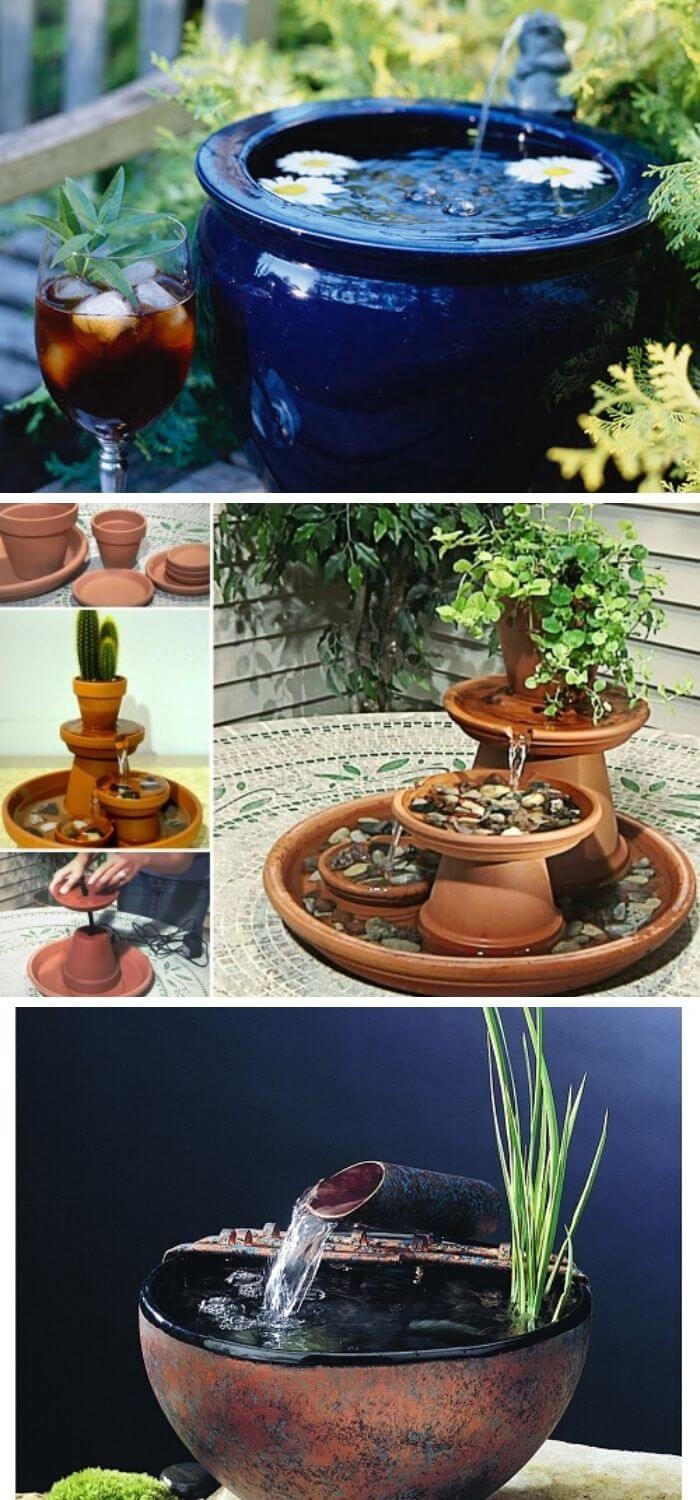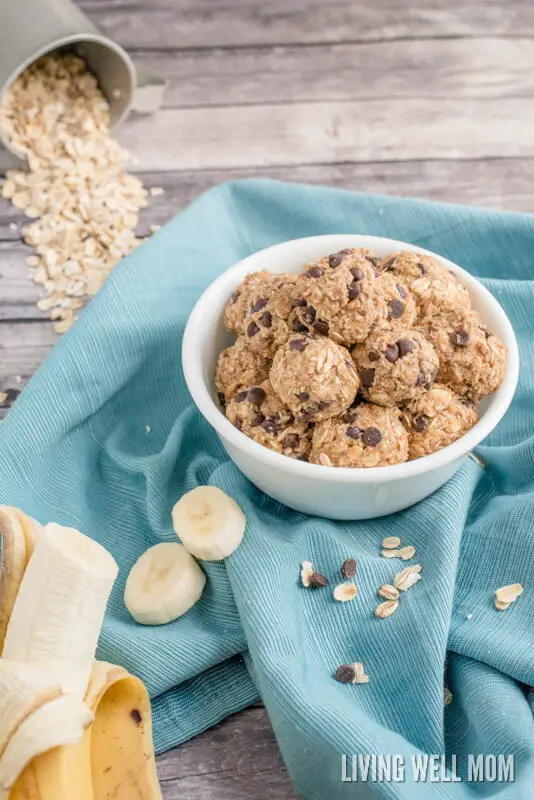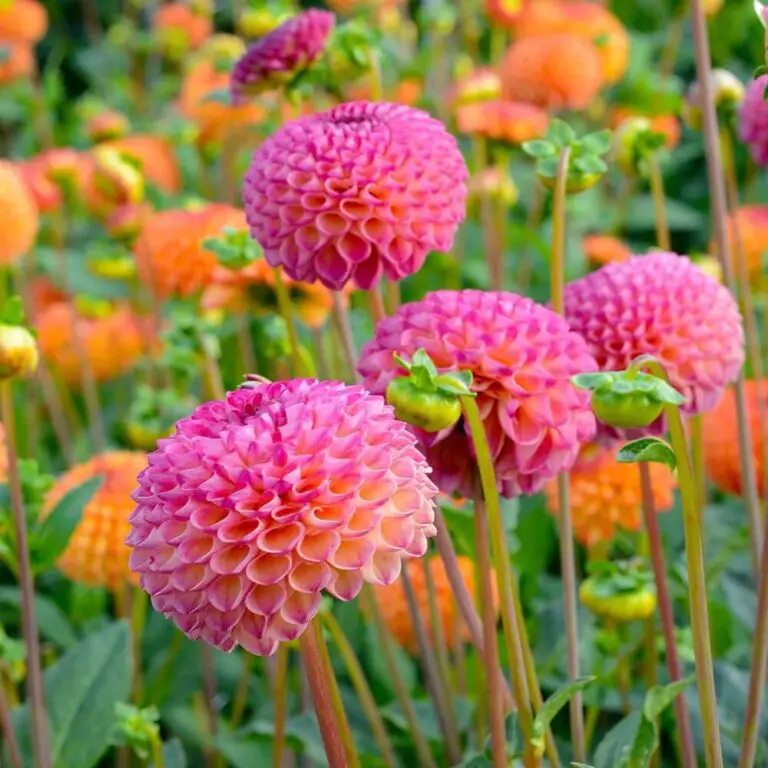35+ Creative Herb Garden Ideas For Indoors And Outdoors
Herbs are a delightful and aromatic addition to any garden or indoor space. Not only do they add a pop of color and fragrance, but they also offer numerous health benefits when consumed. With their compact size, herbs can thrive in small spaces, making them perfect for urban dwellers or those with limited outdoor areas. Planting them in unique containers like teacups, coconut shells, or wooden boxes adds an element of whimsy and creativity to the process.
Whether you’re a seasoned gardener or just starting out, there are countless ways to cultivate herbs. From hanging planters to stacked terracotta pots, each method offers its own charm and benefits. Some herbs can even be grown indoors, suspended from ceilings or placed on shelves, making them accessible year-round. With over 35 herb garden ideas to explore, the possibilities are endless. From repurposed wine bottles to pallet gardens, there’s something for every taste and style.
Check out some of these innovative approaches to get inspired and start your own herb gardening journey!
Herb Garden in a Wine Bottle
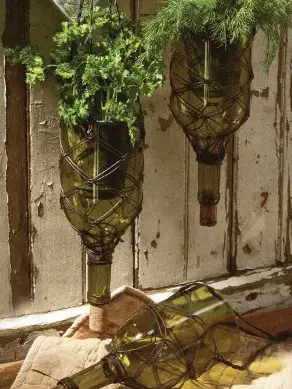
This artisanal herb planter cleverly utilizes upcycled wine bottles to house its verdant contents. The plant names are beautifully inscribed onto stone fragments within the wooden panel, adding a touch of rustic elegance. For those residing in milder climates, cultivating hardy herbs like chives and dill can be a rewarding experience – these plants not only tolerate cooler temperatures but also attract beneficial pollinators while keeping pests at bay.
When it comes to this particular style, opting for herbs that don’t sprawl or become too large is key. Herbs like basil, parsley, lavender, and mint are all well-suited for this planter, offering a delightful mix of flavors and textures.
Potting Herbs
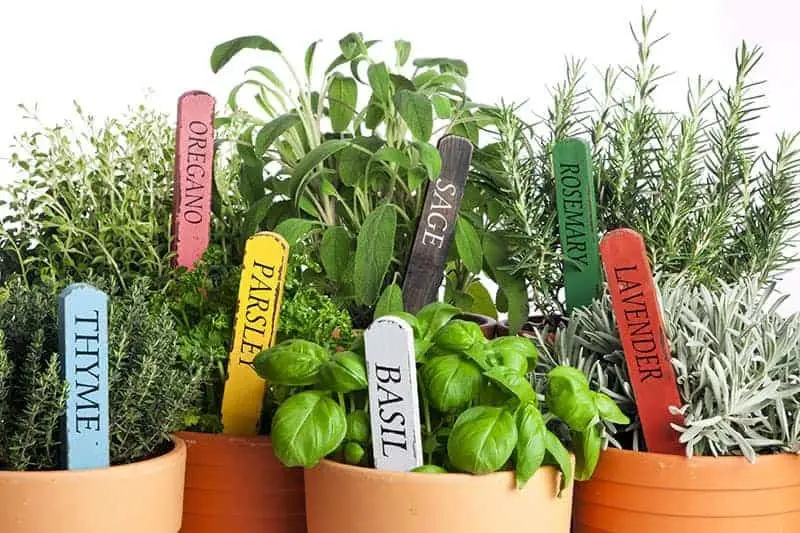
Building a herb garden is a straightforward process that can be achieved by using individual clay pots for each herb species. These pots are not only affordable but also widely available at most garden shops and hardware stores, making them an accessible option for anyone looking to start their own herbal oasis.
One of the best things about these pots is their versatility – they can be used both indoors and outdoors, allowing you to customize your gardening experience based on your climate and personal preferences. For those living in colder regions, this flexibility is especially beneficial. You can take your pots outside during the summer months to give your herbs a boost of sunlight and growth, and then bring them back inside during the winter months to protect them from harsh weather conditions.
Beds on Risers
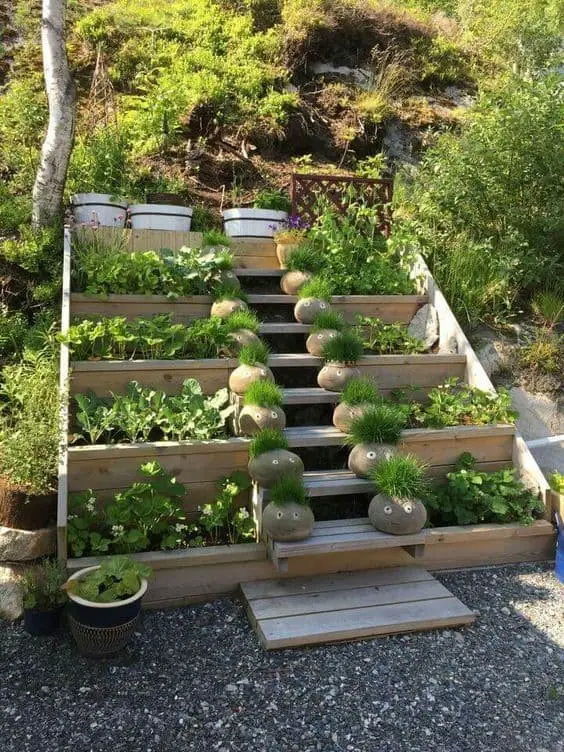
When considering how to build an exterior herb garden, the simplest solution often lies in creating one within a garden bed. One popular approach is to incorporate raised garden bed designs into your landscape, which are not only easy to construct but also offer a unique way to join the ‘grow your own’ trend. Essentially, these elevated beds consist of a rectangular or square frame made from metal, wood, or brick that’s topped with soil.
This design allows for effortless cultivation while standing, making it an ideal option for those who can’t grow at ground level.
Herb Holders Inspired by Kokedama
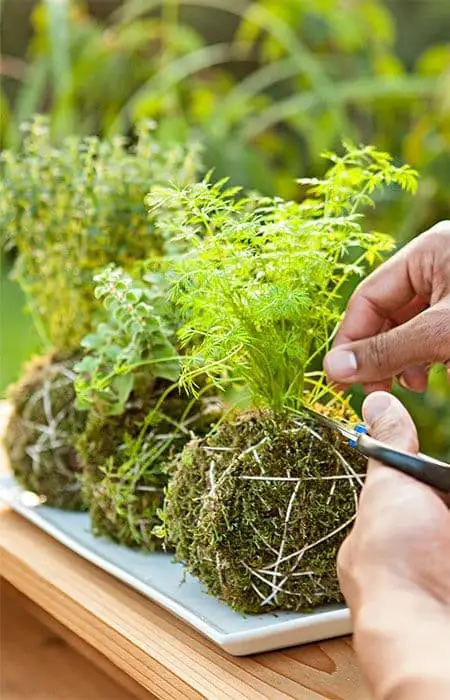
Inspired by traditional Japanese art forms, kokedama is a unique method of displaying plants’ root balls in moss-covered dirt. This visually striking technique has been applied to create an herb planter trio, showcasing the beauty of herbs like oregano. When cultivating this fragrant herb, it’s essential to provide it with sufficient sunlight, preferably from a west- or south-facing window. A well-drained garden soil is also crucial, as oregano doesn’t tolerate wet conditions.
Reduce, reuse, and recycle
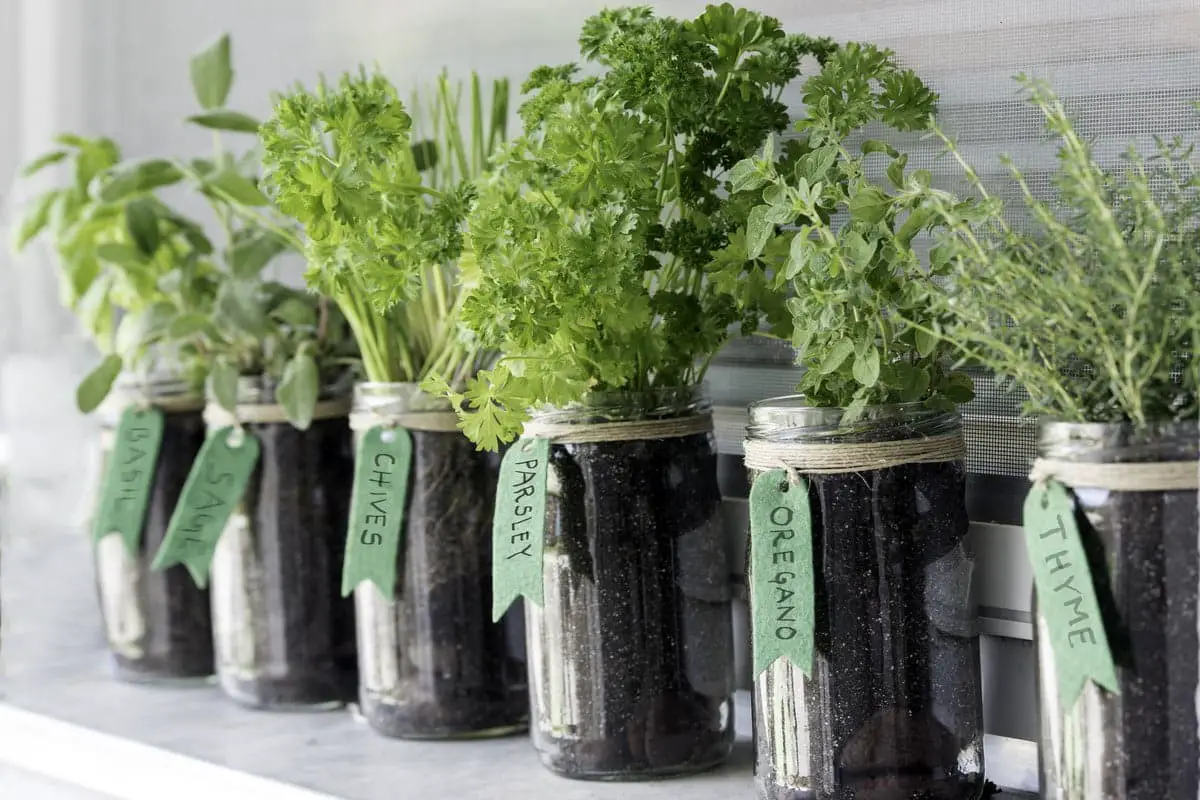
Transforming used mason jars into herb plant holders not only adds a touch of elegance to your space but also champions sustainability. The cost-effectiveness of this approach is undeniable, and the visual appeal of lining up multiple jars creates a striking display. To further enhance the vintage charm, incorporate string, printed labels, garden ribbon, and playful stickers or scribbled notes on the labels.
As you cultivate a diverse range of herbs for culinary use, you’ll find yourself drawn to this eco-friendly concept.
In one border, plant herbs.
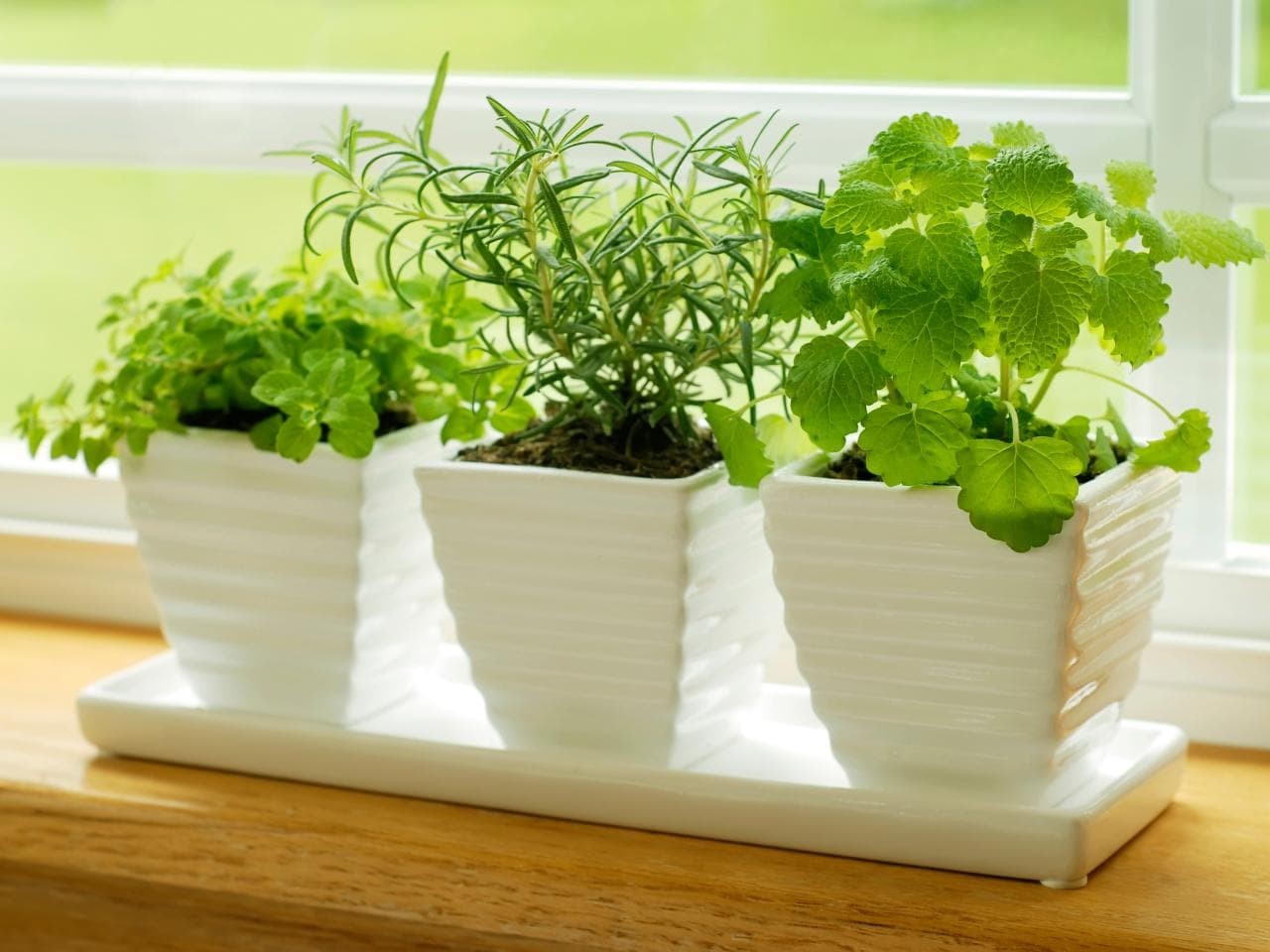
Transform your outdoor space into a thriving herb haven without dedicating a large area. One innovative way is to incorporate herbs into your blossom and bush border. This not only adds visual appeal but also releases fragrant aromas and provides culinary value. Furthermore, certain herbal varieties can offer supplementary benefits for surrounding plants, such as natural pest control or enhanced yield.
Herb Garden on Pallets
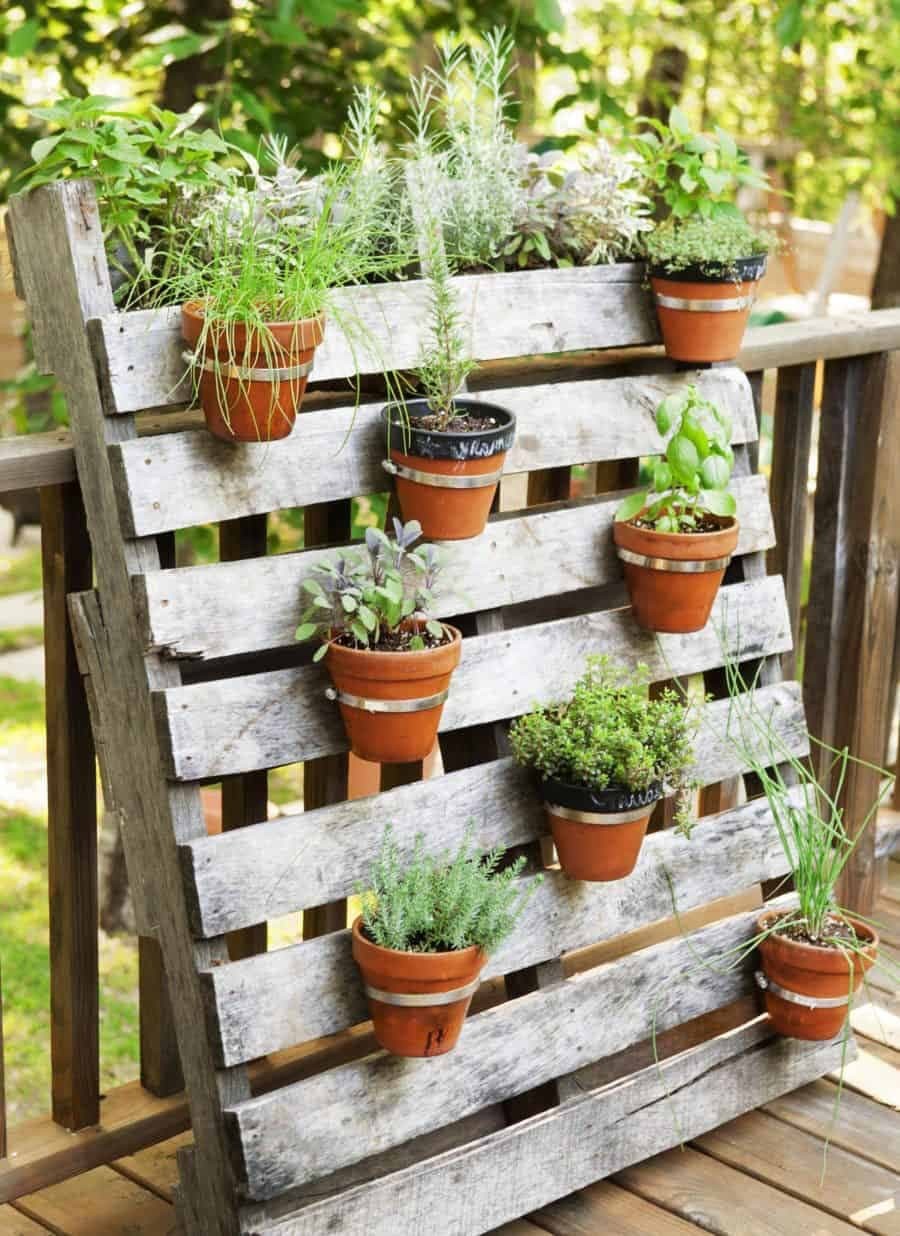
Transforming an old wooden board into a lush herb garden is a fantastic way to upcycle and add some greenery to your outdoor space. Start by selecting herbs that thrive in your USDA planting zone, and consider painting or staining the boards to match your garden’s aesthetic. For a diverse collection of herbs, tiered arrangements are perfect.
Take basil and dill as examples – being annuals, they’ll eventually finish their growth cycle, but you’ll still have plenty of other options to choose from among your remaining herbs.
Round and Round It Goes
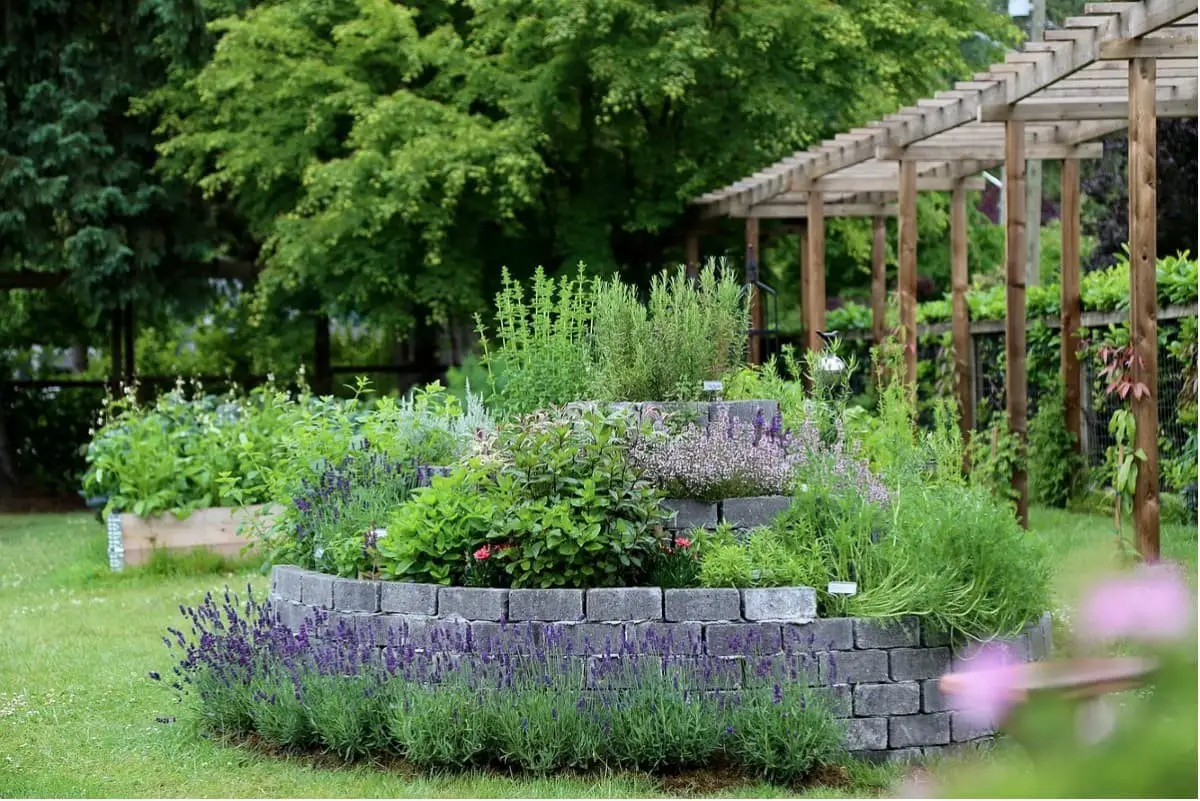
By incorporating herbs into a spiral pattern within your garden, you can create an ideal environment for their growth. As different herbs have distinct care requirements, a spiral design allows for tailored attention to each plant’s unique needs. Herbs that thrive in direct sunlight can be placed at the top of the spiral, while those preferring partial shade or high humidity can be situated at the bottom.
The top of the spiral is also ideal for drought-tolerant herbs that benefit from good drainage. This visually striking design not only fosters healthy plant growth but also serves as a beautiful focal point in your yard.
Planter for herb gardens on patios

With limited outdoor space, you can still cultivate a thriving organic garden in a single container. For instance, a small courtyard or even a porch can be the perfect spot for a compact planter. Alternatively, you can utilize terracotta herb pots with varying hole sizes to grow distinct plants in different areas of the same pot. This clever arrangement allows for optimal use of space and promotes healthy plant growth.
The porous nature of terracotta is particularly beneficial as it enables airflow and water circulation, thereby preventing fungal diseases and root rot that can harm your plants. By incorporating these creative container gardening techniques, you can enjoy a bountiful harvest despite spatial constraints.
Hangers for Mason Jars

Are you stuck with a collection of idle mason jars? Why not repurpose them into a charming planter for herbs? Simply attach the jars to a wooden panel and fill them with a medley of herbs, both inside and out. Since mason jars don’t naturally have drainage holes, be sure to add water in moderation, up to one-third of the container’s capacity at a time, to prevent rot root from setting in.
Planters on Wheels
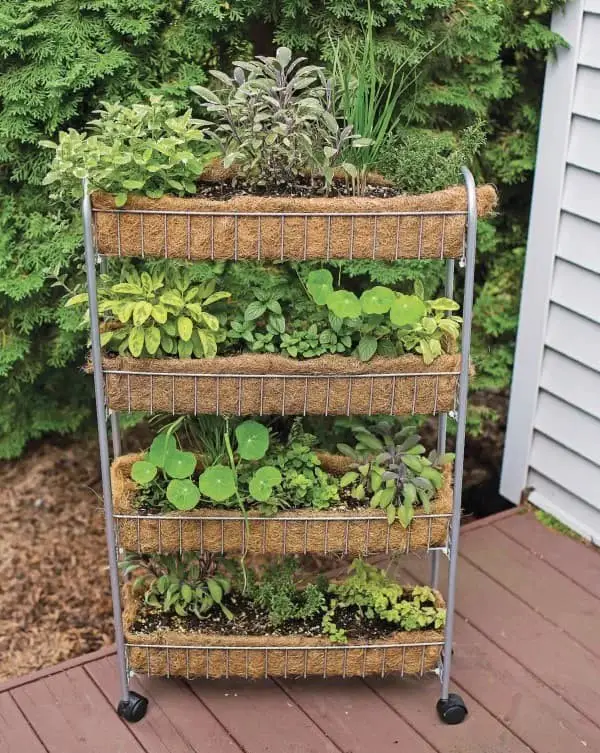
Transform any hollowed-out space in your home or shed into a thriving herb garden. An old bucket with a galvanized finish provides an industrial-chic backdrop for a variety of potted herbs, but you can also repurpose items like teapots, watering cans, paint tins, mugs, or even ice cream containers to create a unique and functional display. To prevent the soil from becoming waterlogged, drill a hole in the bottom of your chosen vessel.
The benefit of housing all your herbs in one portable container is that you can easily move them indoors or outdoors depending on the weather.
For added appeal, create a vertical herb garden.
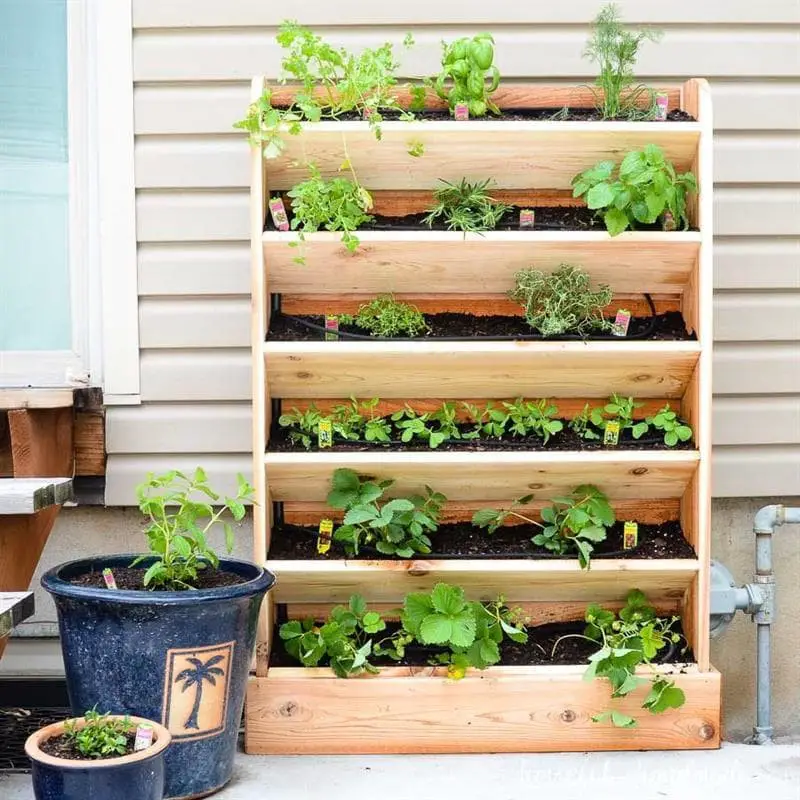
When it comes to maximizing your garden space, consider taking advantage of vertical gardening techniques for your herbs. By doing so, you can create a lush oasis without sacrificing valuable area. One creative approach involves repurposing a rustic wooden ladder into a unique focal point that adds visual interest and depth to the space. This clever hack not only saves floor space but also provides an opportunity to showcase your personal style through upcycled decor.
Planters with Trellis
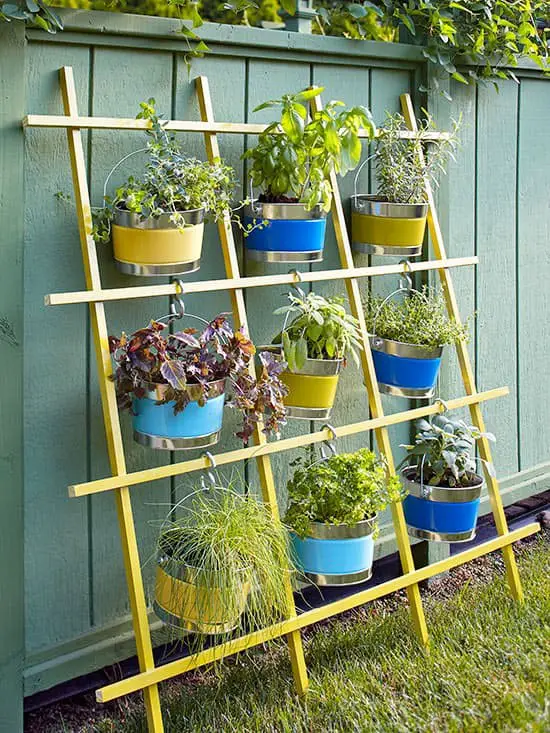
Positioned on a sunny patio, these herb-filled planters are securely attached to trellis supports, offering ample space for multiple varieties of herbs. When choosing to grow multiple herbs in one planter, select combinations that share similar growth requirements. This approach allows the faster-growing herbs, such as mint, to thrive without overwhelming other plants nearby.
By containing mint’s spreading tendencies within a larger pot, you’ll eliminate concerns about its influence on surrounding flora.
Basket Case
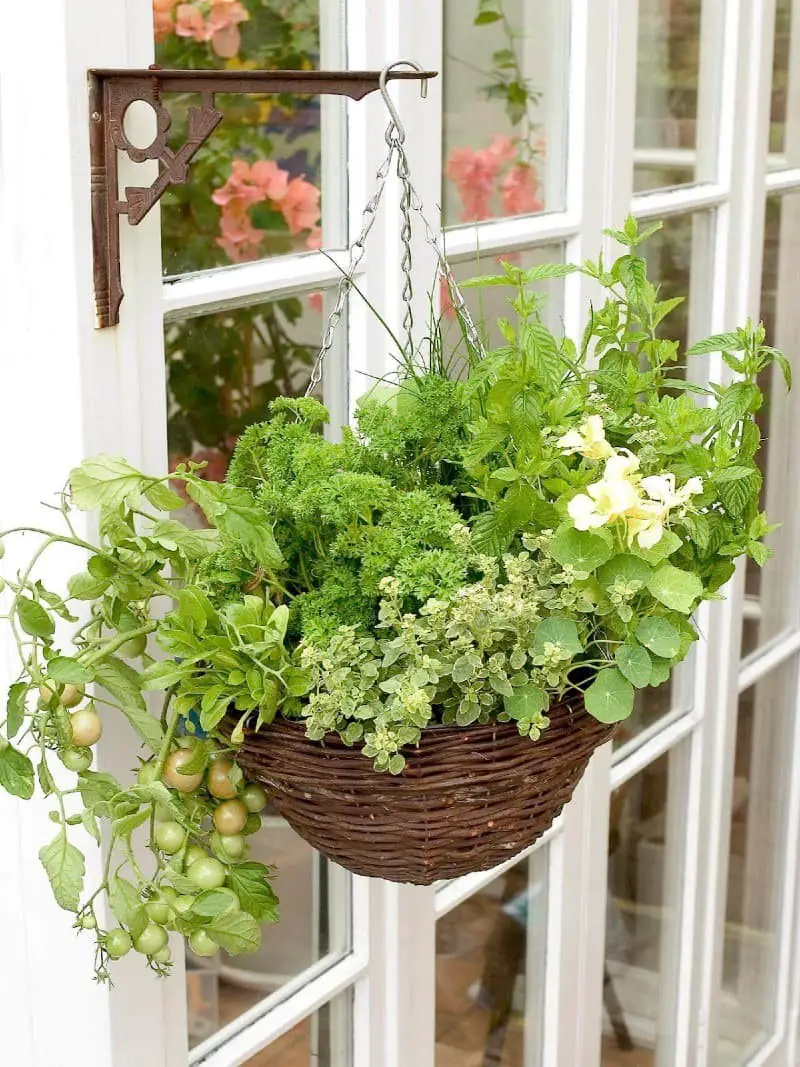
Adding a herb garden to your home not only enhances its aesthetic appeal but also purifies the air. Create a visually appealing display in your dining area or kitchen by planting a variety of herbs in a decorative container. You can choose from an array of options, such as a woven basket for a warm and classic look, an antique hardwood wine box or produce box for a more rustic appearance, or get creative with updated vintage pots or jars to match your interior design.
With a twist, here’s an indoor herb concept.
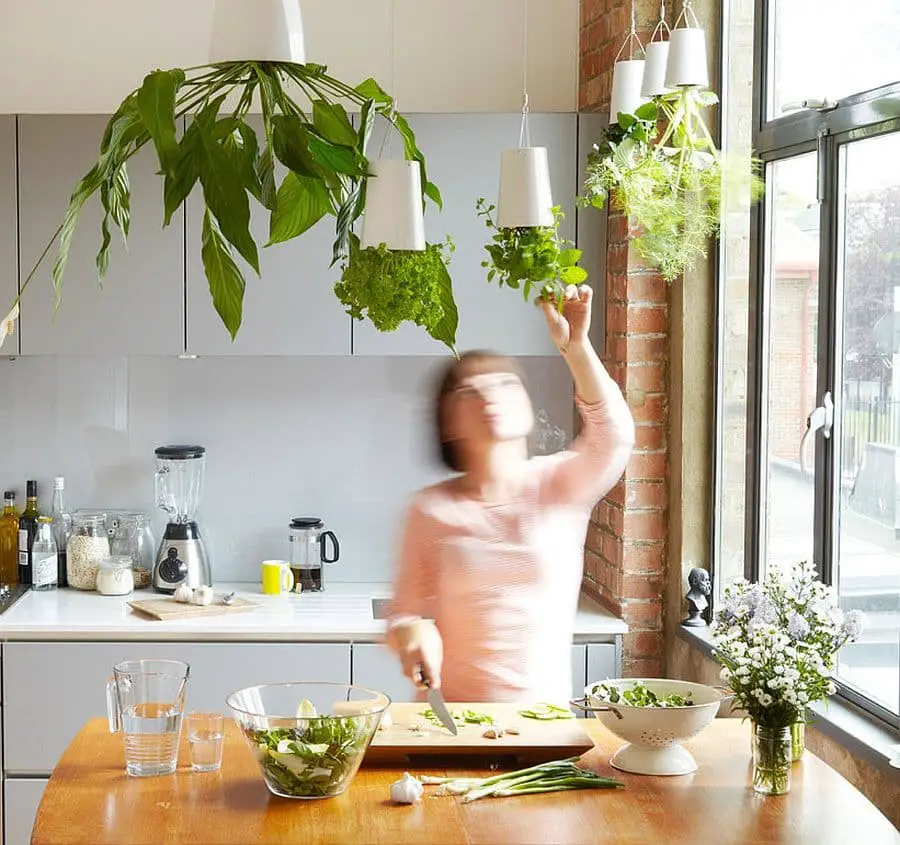
While outdoor vertical planting is an excellent option, there are other creative ways to cultivate herbs in the kitchen, even without a windowsill or space cluttered with potted plants. A practical alternative is hanging pots from the roof or ceiling, which not only frees up worktop space but also adds a touch of elegance to your kitchen’s decor.
For instance, an innovative Ikea hanging pot can be mounted on the ceiling, taking up minimal room while still allowing you to grow your favorite herbs. Alternatively, consider dangling pots from cutlery holders or placing them on bookcases – these unconventional methods will keep your kitchen organized and herb-filled without sacrificing style.
Retro Chandelier that has been repurposed
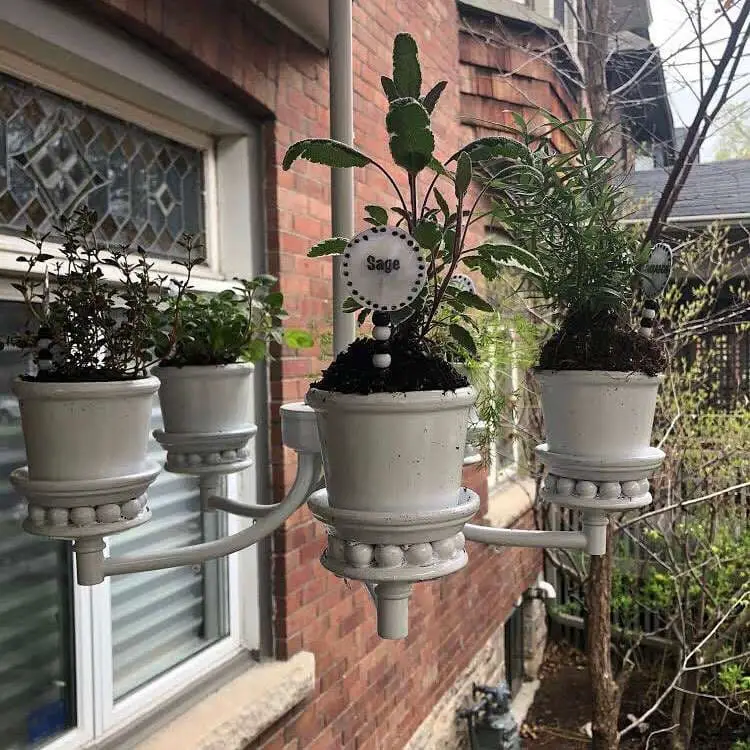
Transforming ordinary objects into something extraordinary unlocks a wealth of innovative opportunities. Imagine upcycling this vintage chandelier into a suspended planter for a lush herb garden, perfect for adding a touch of elegance to any outdoor space. Just be sure to apply a waterproof coating or varnish to ensure its longevity in the elements. Alternatively, bring the charm indoors and reimagine it as a unique feature for your retro-styled mid-century modern home.
Make a Statement

Transform any space into a charming herb garden by repurposing containers you already have. Whether it’s your kitchen, dining area, or backyard, mismatched pots filled with diverse herb plants can add a pop of color and visual interest. The key is to create an eclectic effect by combining containers of different shapes, sizes, and styles. By shying away from uniformity and height order, you can achieve a relaxed, casual ambiance.
Simply arrange the pots in a random manner that suits your personal taste, and you’ll be surprised at how effortlessly a unique herb garden comes together.
Herb garden with a twist for limited places
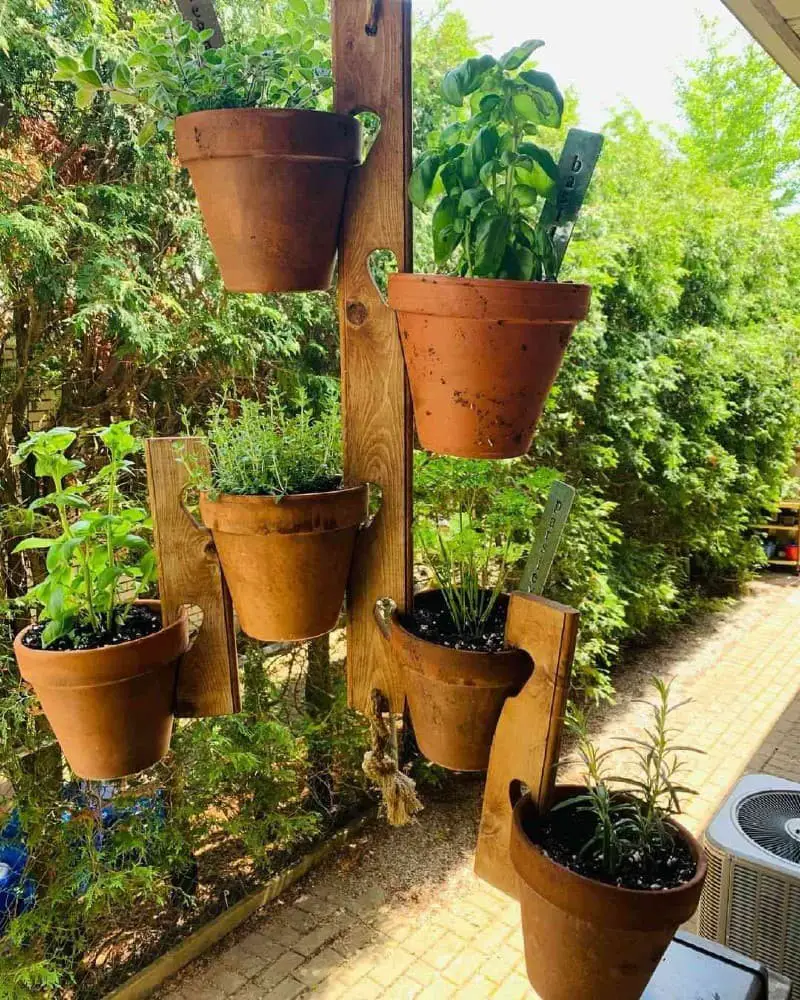
Starting an herb garden as a beginner can be intimidating, especially when working with limited space. One effective way to overcome this challenge is by utilizing containers, which are not only easy to maintain but also add visual appeal when grouped together or hung on a wall. Many herbs thrive in full sunlight and well-drained soil, making them ideal for Mediterranean climates.
By cultivating a few favorite herbs in pots on your balcony, terrace, or patio, you’ll have the perfect setup for effortless harvesting and incorporating fresh flavors into your meals – a delight to share with friends and family.
Design that is simple
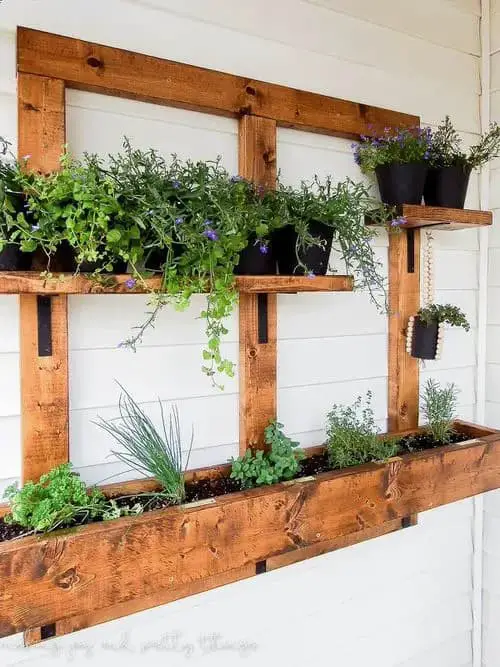
Whether you’re looking to plant herbs that require well-draining soil, or seeking a versatile planter for your outdoor space, this small project combines the best of both worlds. By joining classic planters to a repurposed plank of wood, you’ll create a design that’s as practical as it is visually appealing.
And the beauty of this setup lies in its simplicity – allowing you to place your plants anywhere, whether indoors or out, without worrying about the limitations of traditional vessels with drainage.
Herbs on the Shelf That Are Good For You
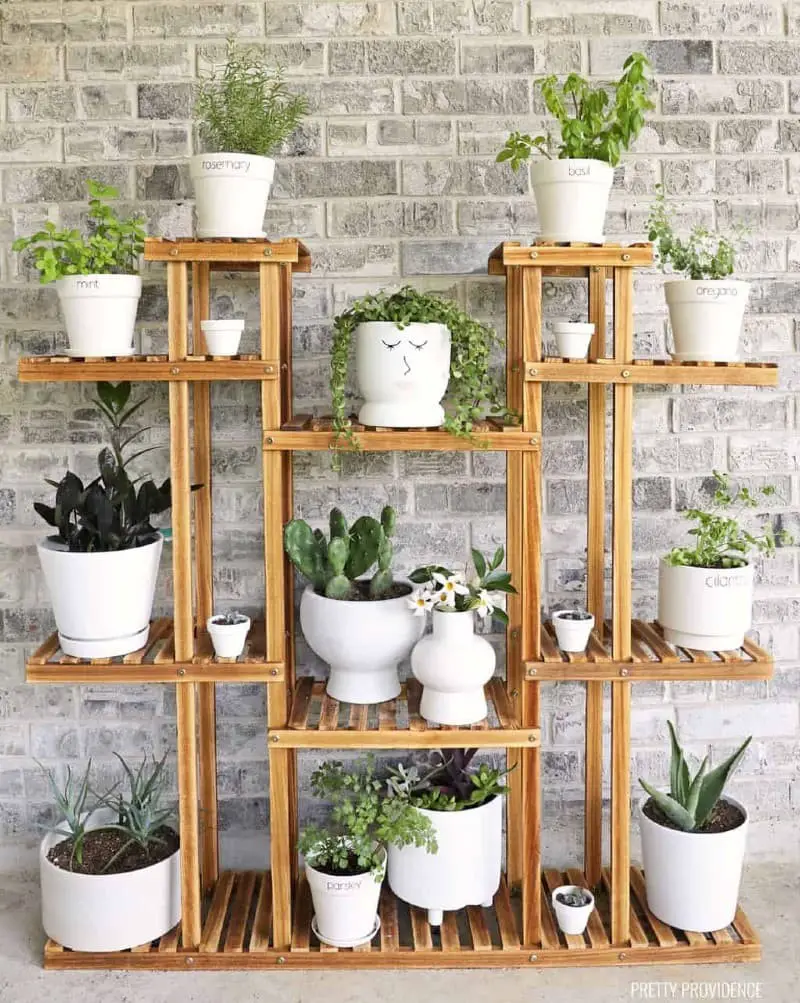
When space is a concern in your garden, consider utilizing a rack to store your herbs. To free up additional area for herb containers and other plants or flowers, install a shelf suspended from a fence, metal railings, or wooden fence. Options include purchasing pre-made shelves or creating your own using simple wood planks and steel brackets. If you opt to build your own, be sure to cure the wood first to ensure durability.
Once complete, simply arrange your herbs on the racks and enjoy the benefits of having them readily accessible.
Vases filled with herbs
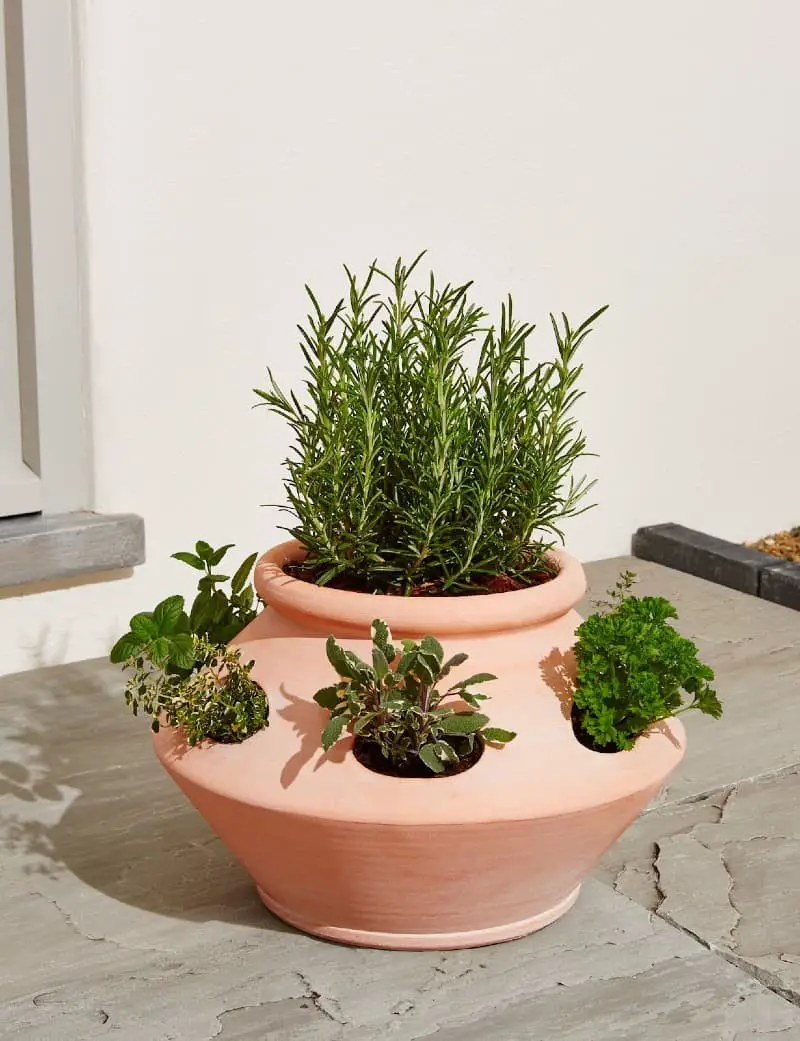
When it comes to utilizing herbs in your kitchen, having them readily available is key. Consider growing them near the back entrance or clipping sprigs and storing them in water-filled containers, similar to how you would care for cut flowers. This way, your favorite herbs are always within arm’s reach and ready to use whenever you need them.
Planters made of macrame

As macrame continues to gain traction among enthusiasts of vintage fashion, its applications have expanded to encompass a wide range of creative endeavors. One such example is the creation of suspended planters, which can be easily sourced from merchants or crafted independently by following a guide. However, it’s essential to ensure that the structural integrity of your design is sufficient to support the weight of the herb planters, which will ultimately take pride of place within.
Simple Homemade Fix
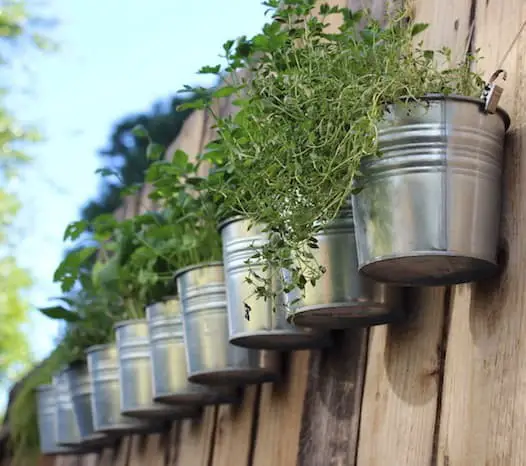
Elevate your outdoor space with a beautifully simple dangling herb garden design. To create this look, start by installing multiple hanging bars on your fence or wall. Next, select a collection of jars featuring knobs or nail holes that can be easily suspended from the rails using sturdy rope.
Warming Herbs
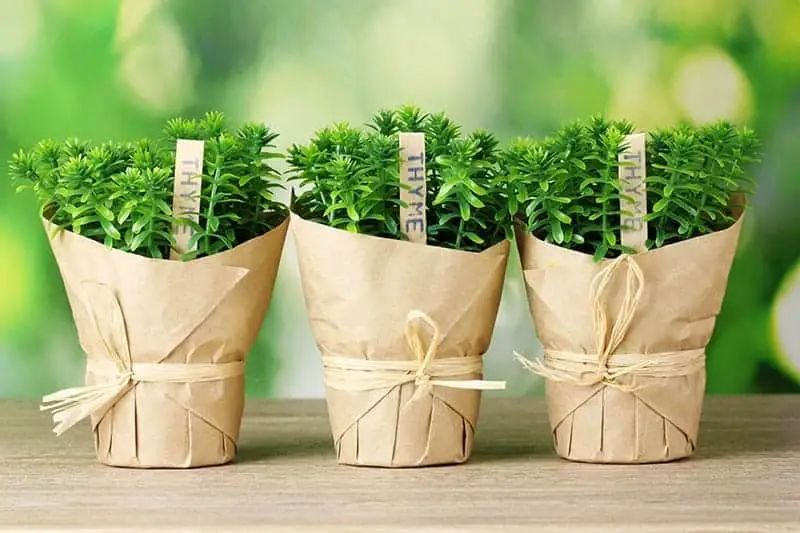
Herb plants have become a popular choice for gifts, particularly at housewarming parties, as they offer a unique alternative to traditional flowers or houseplants. To make the gift even more thoughtful, consider selecting an herb that aligns with the recipient’s culinary preferences. For instance, a basil plant might be perfect for an Italian food enthusiast, while dill could be a great choice for someone who loves fish dishes.
When it comes to presenting the gift, wrapping the plant in parchment paper can add a charming rustic touch. Not only is this approach more visually appealing than traditional store-bought wrapping materials, but it’s also environmentally friendly and recyclable. This thoughtful present has an added benefit – the herb plant will continue to grow and provide a long-term benefit for the recipient, potentially lasting months or even years.
Window Boxes with herbs
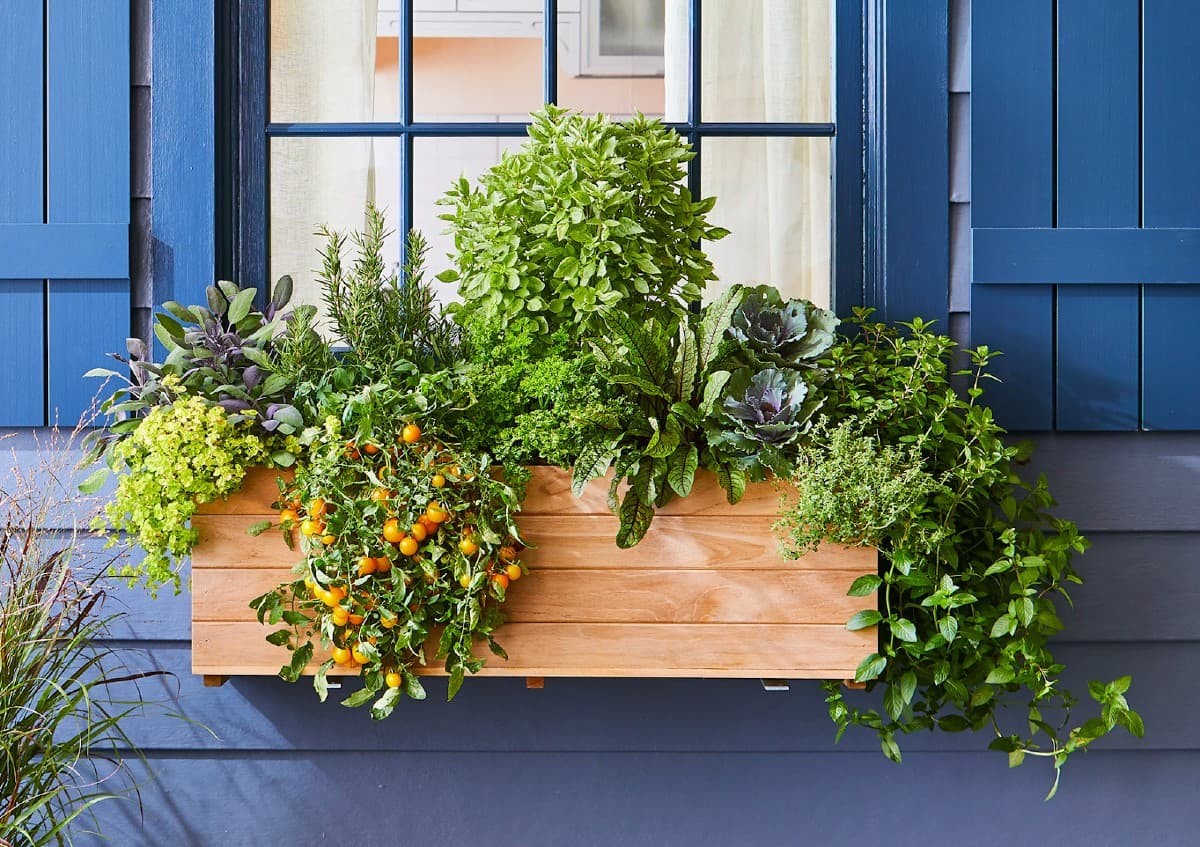
Growing herbs in window boxes offers a convenient way to cultivate your favorite herbs both indoors and outdoors. This method allows for easy access to fresh herbs, going from plant to plate in mere moments. For those with limited outdoor space, an indoor window box can be a great option. It adds a charming touch to your home’s exterior, and you can pair herbs with flowers to create a visually appealing display that also provides a pop of color and artistic flair.
Hanging Herb Garden with Multiple Tiers
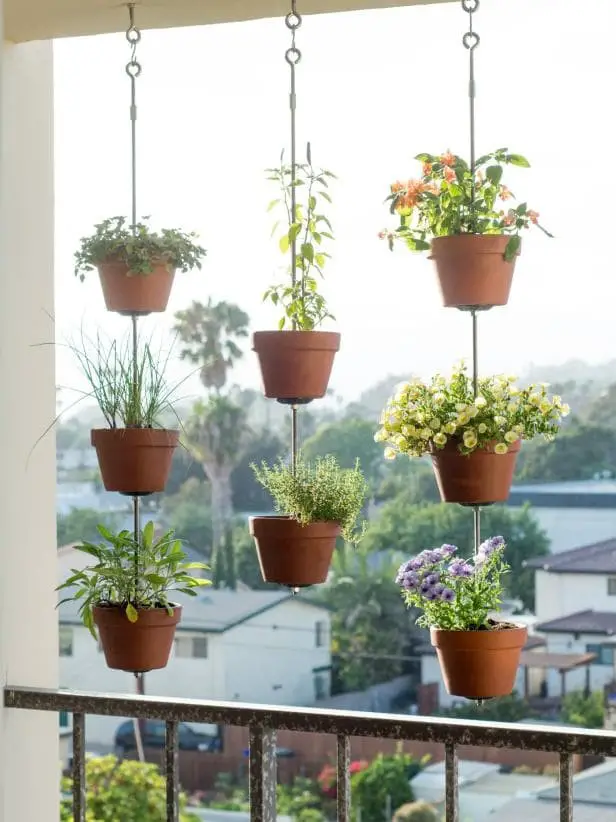
For those looking to take their DIY skills to the next level, building a multi-tiered suspended herb garden is an excellent project that can thrive in a sunny spot. One of the benefits of this type of gardening is its suitability for herbs with modest root systems that don’t require large pots. This flexibility makes it easy to create a compact and visually appealing display of your favorite herbal varieties.
Planters made of terracotta that are stacked vertically

When space is limited, this DIY project can be effortlessly hung from porch eaves or other areas where traditional wall mounting isn’t feasible. For added ambiance, choose aromatic herbs like lavender, basil, or lemon balm, which will release their delightful scents into the surrounding environment as you relax outdoors. The terracotta pots used in this project boast a unique combination of aesthetic appeal and practical functionality.
Their high porosity allows them to thrive with drought-tolerant plants that prefer well-draining soil conditions. This feature not only reduces watering needs but also minimizes maintenance, making it an ideal choice for busy homeowners or those new to gardening.
Tables for Outside

Transform the ambiance of your backyard by utilizing a table as a makeshift herb garden stand. Strategically position it to maximize exposure to sunlight and create dappled shadows that highlight the textures and colors of your plants. You can place other foliage on top, carefully arranging them to optimize space and create a visually appealing display. To ensure durability, opt for an outdoor table designed specifically for exterior use, such as one with a weather-resistant coating.
Alternatively, breathe new life into old or discarded furniture by repurposing it as a unique herb garden stand, perhaps inherited from friends or family members.
Herb Garden Suspended in the Air
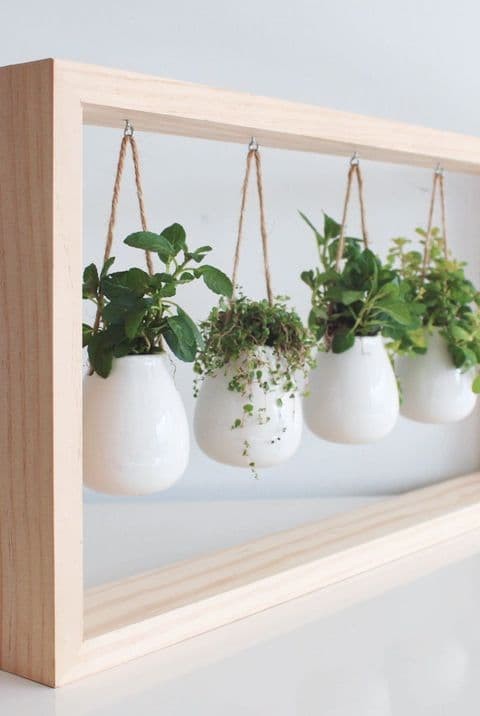
This innovative aerial swinging herb garden is a space-saving marvel crafted from reclaimed wood. Its unique design allows for a generous quantity of herbs to thrive in a compact footprint. However, it’s essential to maintain a balance by avoiding overfilling, which might obstruct the sunlight necessary for the lower-level plants. The cleverness of this concept lies in its ability to adapt to changing seasons.
When winter arrives, you can effortlessly remove the pots and relocate them indoors, providing a cozy environment for your herbs to overwinter.
Creating a Corner
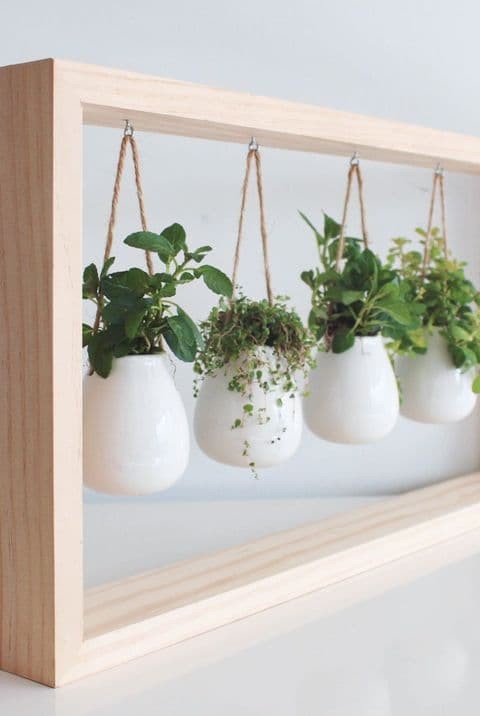
When it comes to cultivating herbs, dedicating a designated area for their growth is essential. This not only protects your herbs from the competition of other plants but also keeps them out of harm’s way. If you have young children or pets that frequent your garden, selecting a secluded spot will ensure your herbs remain safe and untouched. Furthermore, choosing an area with minimal foot traffic will prevent accidental damage to your herb plants.
Garden on the Rooftop

For those who call apartments home, cultivating an herb garden can still be a feasible and enjoyable endeavor. By utilizing container gardens and strategically placing them on balconies or rooftops, even urban dwellers can reap the benefits of fresh herbs. And the good news is that these hardy plants are surprisingly resilient, requiring only sufficient natural sunlight to thrive in unexpected places.
Planter for Cascading Rails
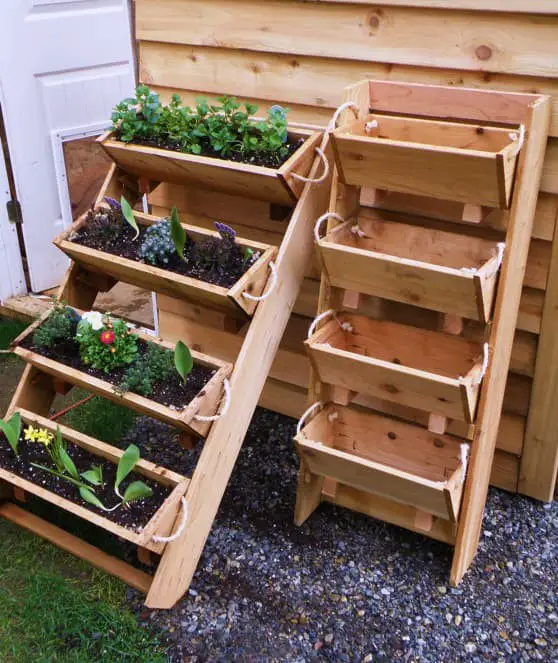
A prime spot for a floating herb garden is on the railing of your kitchen that leads out to your backyard. This setup allows you to optimize your plant placement based on their sunlight requirements. Place the herbs that demand full sun at the top level, and those that can tolerate partial shade on the lower tier.
Hanging Ladder

Transform ordinary wooden ladders into an unexpected haven for your favorite herbs by leveraging the radiant light streaming through a glass window. A medley of fragrant flora, including oregano, thyme, and parsley, can be nestled within bucket planters to create a lush oasis. Meanwhile, sun-loving herbs like cilantro, basil, and lemongrass will flourish in the direct sunlight, filling the air with their invigorating aromas.
Polytunnel for Protection
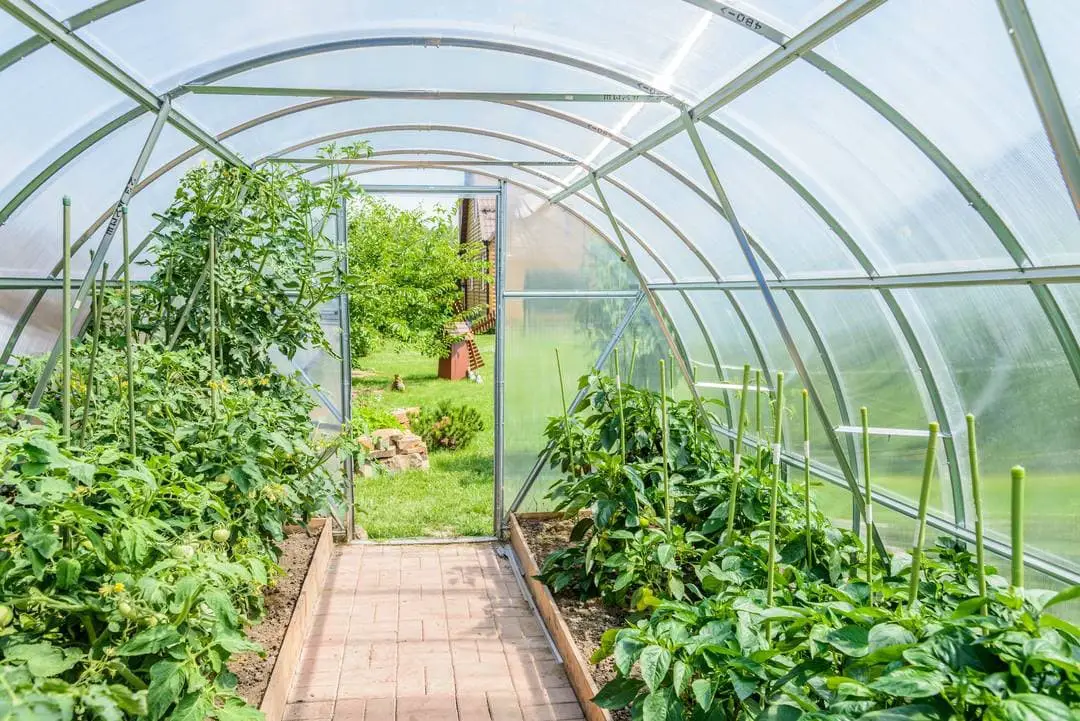
For those looking to extend their herb-growing season year-round, a polytunnel is an excellent option. These structures come in a range of sizes and are made from polythene, a cost-effective yet durable material that shields plants from harsh weather conditions, pests, and animals. The polythene also retains heat and humidity, much like a greenhouse, creating a warm and humid microclimate that enables earlier planting and faster plant development.
Plus, polytunnels can be easily dismantled and relocated to other areas of your garden when needed.
Fenced In
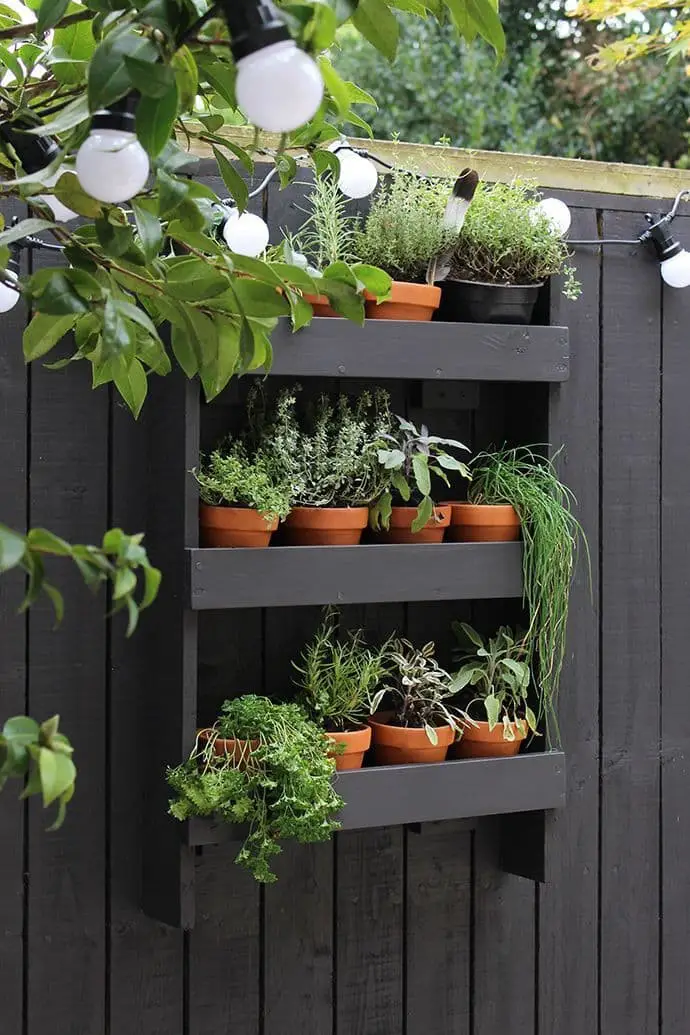
This ingenious herb garden has taken the concept of enclosure to its natural conclusion, literally building a picket fence around each potted plant. This innovative approach serves as a prime example of how you can unleash your creativity and showcase your individuality by repurposing an ordinary herb plant into a unique representation of yourself.
To further enhance this idea, consider experimenting with diverse containers or upcycling boxes by covering them in wallpaper or fabric to give them a fresh makeover. For those looking to create their own wooden fence, scour online marketplaces for small panels that can be used to construct a personalized barrier for the herb garden.
FAQs
What herbs could be planted together?
When selecting herbs to plant together, consider those that thrive in similar environments. Many popular herb varieties, such as thyme, sage, marjoram, lavender, rosemary, and oregano, can be successfully cultivated alongside one another. However, it’s essential to note that some herbs, like mint, require special attention due to their invasive nature and should not be planted among other species.
What should I plant in my herb garden?
To cultivate these essential herbs, all they need is plenty of sunshine, consistent watering – especially during the warmer summer months – and proper drainage to flourish in your own home. Regular harvesting will not only keep them healthy but also encourage fresh growth. Herbs like thyme, chives, basil, mint, parsley, oregano, and lavender fit into this category.
Mason Jar Herb Garden
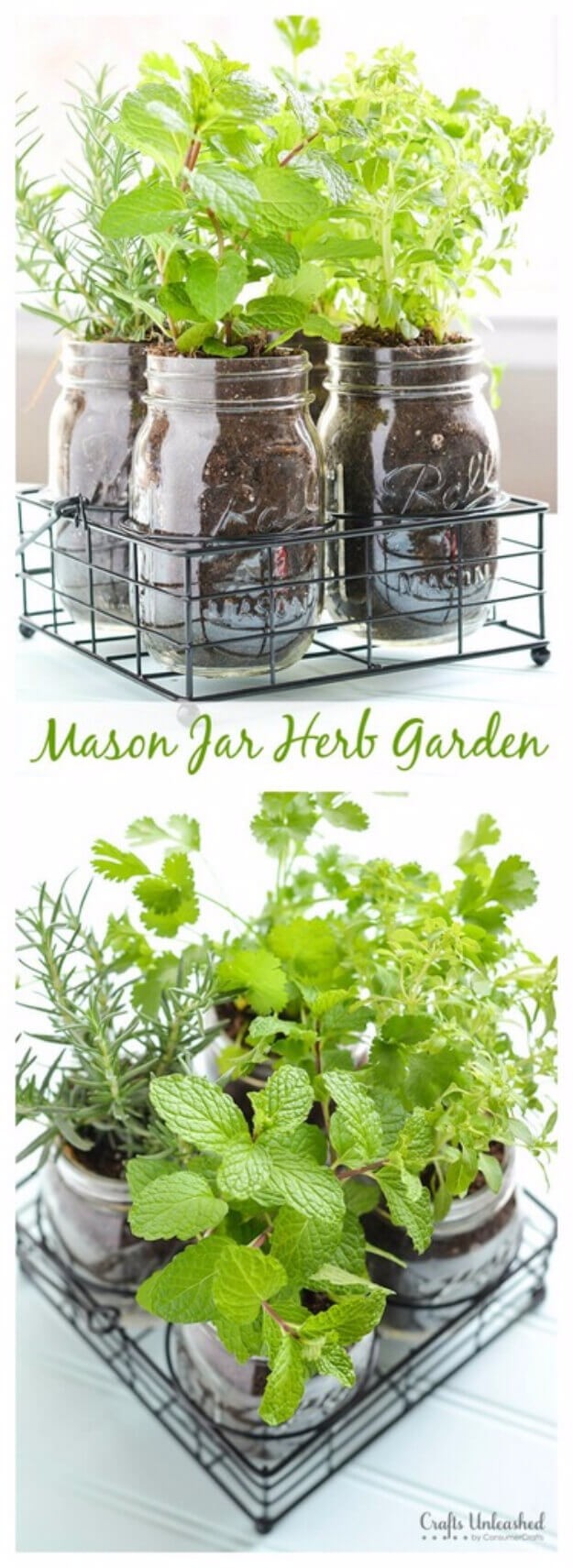
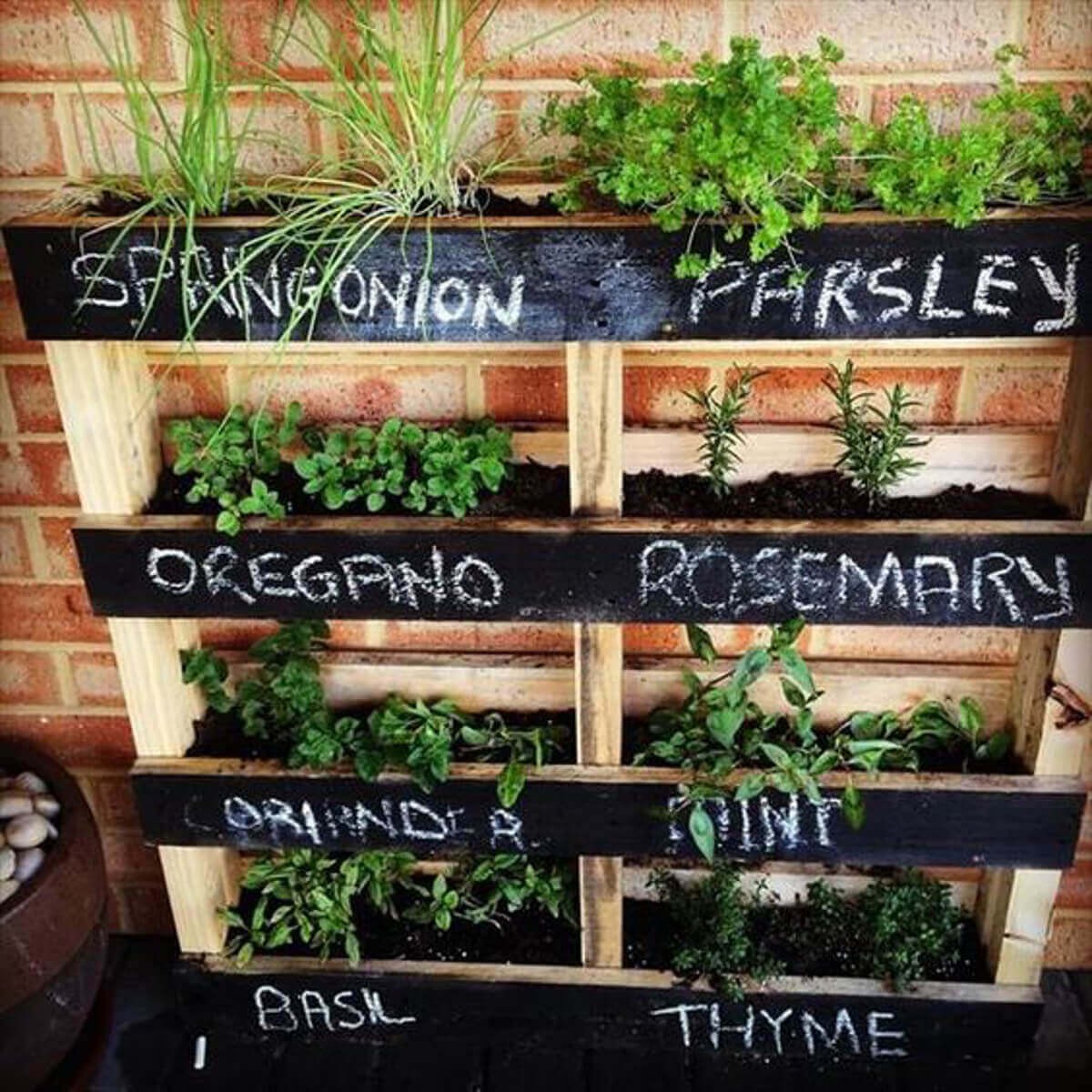
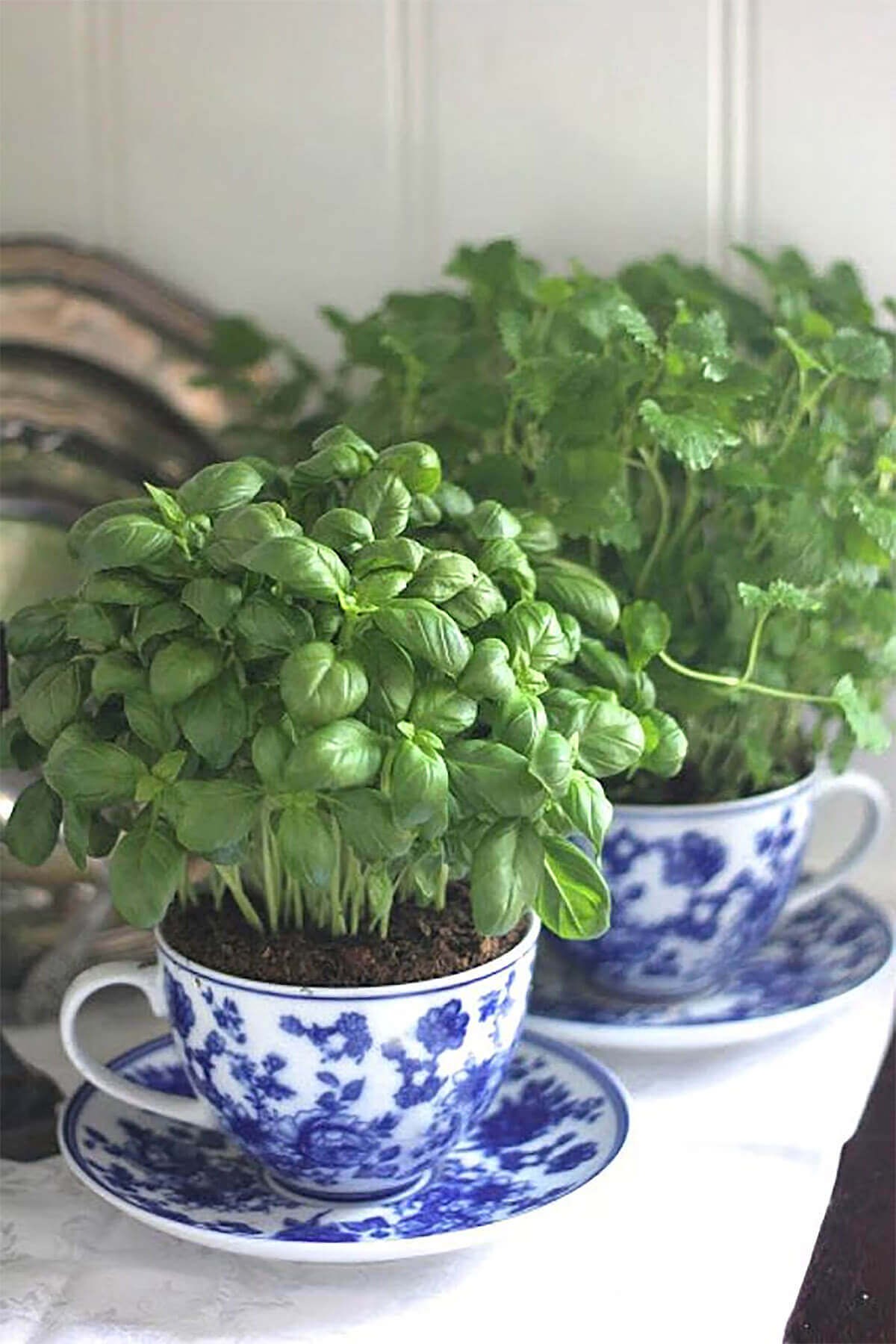
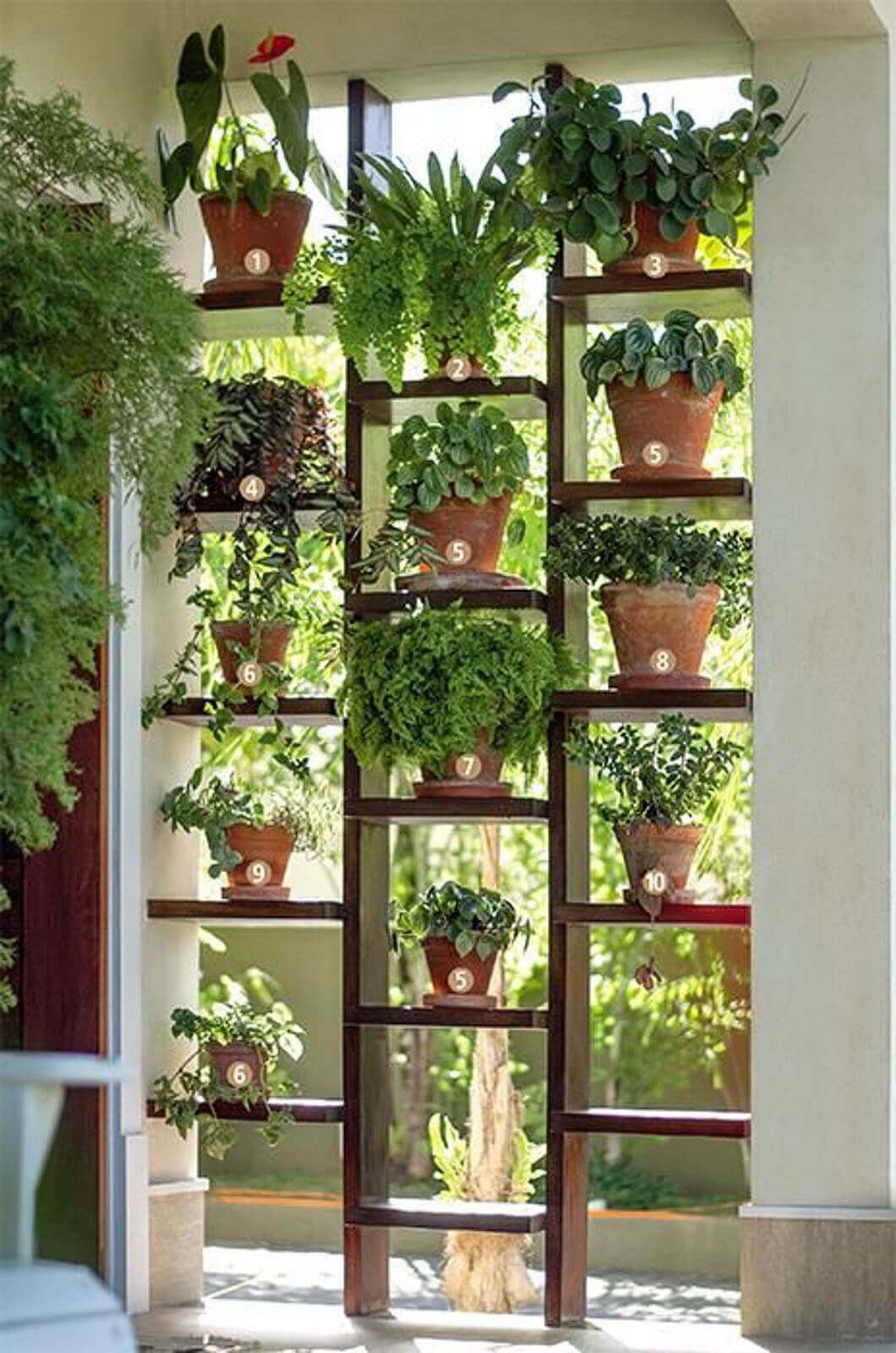

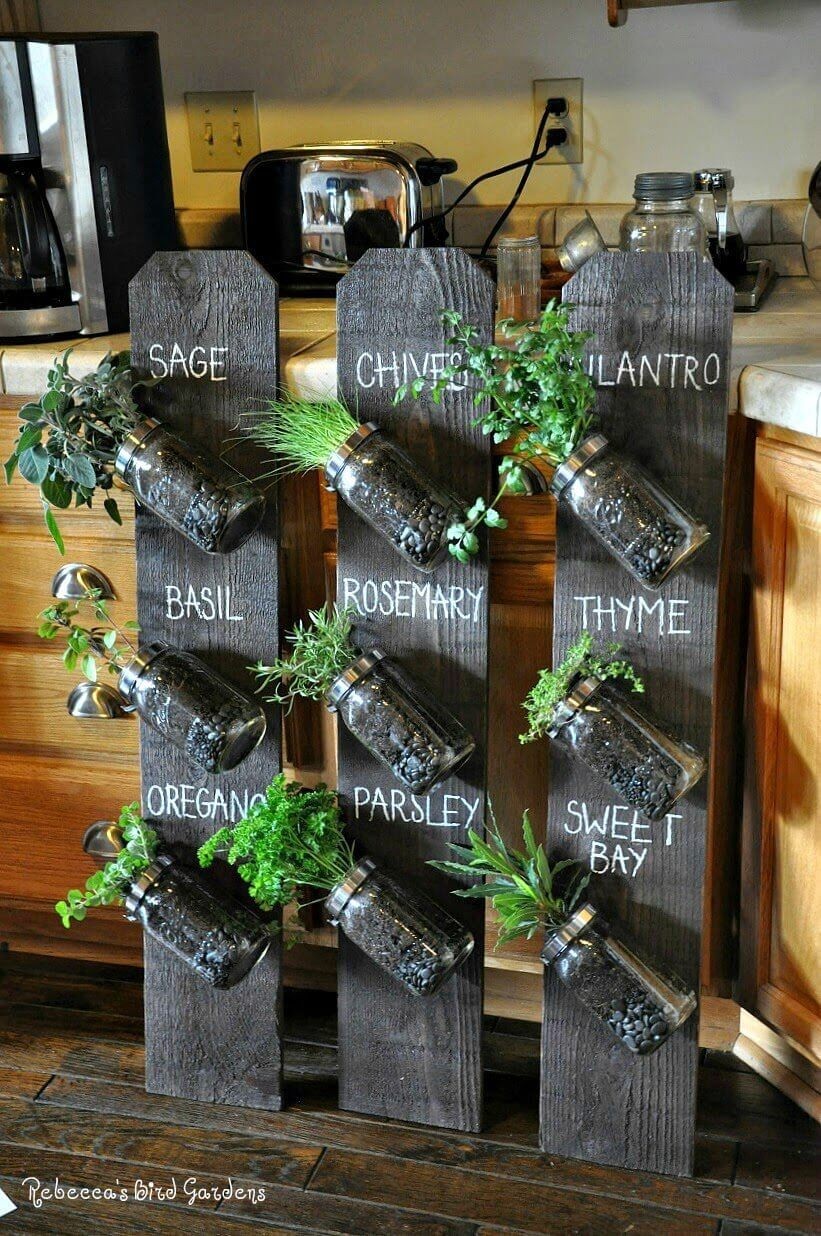
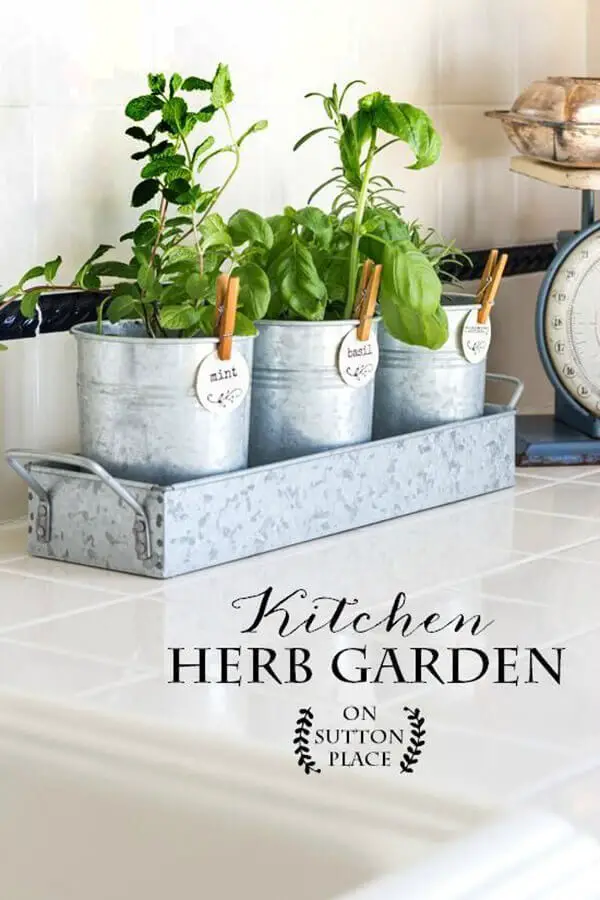

When it comes to discovering unique and creative blogs, the internet is filled with endless possibilities. From crafty endeavors to artistic expressions, there’s no shortage of inspiring websites out there. In this post, we’ll be highlighting some of our favorite online destinations for those looking to tap into their inner creativity. We’re talking about 99pallets. com, a treasure trove of DIY ideas and tutorials that will have you upcycling like a pro in no time. Next up is getcreativejuice.
com, where the focus is on unleashing your creative potential through art, writing, and other forms of self-expression. For those with a passion for home decor and design, estiloydeco. com and camillestyles. com are must-visits. And if you’re an avid gardener or bird enthusiast, rebeccasbirdgardensblog. blogspot. hu is the perfect place to get your fix of all things feathered and green. Last but certainly not least, onsuttonplace. com offers a wealth of information on lifestyle, travel, and culture.
Whether you’re looking for inspiration for your next DIY project or seeking out new hobbies and interests, these blogs are sure to spark some creativity in your life.
Tiered Herb Garden
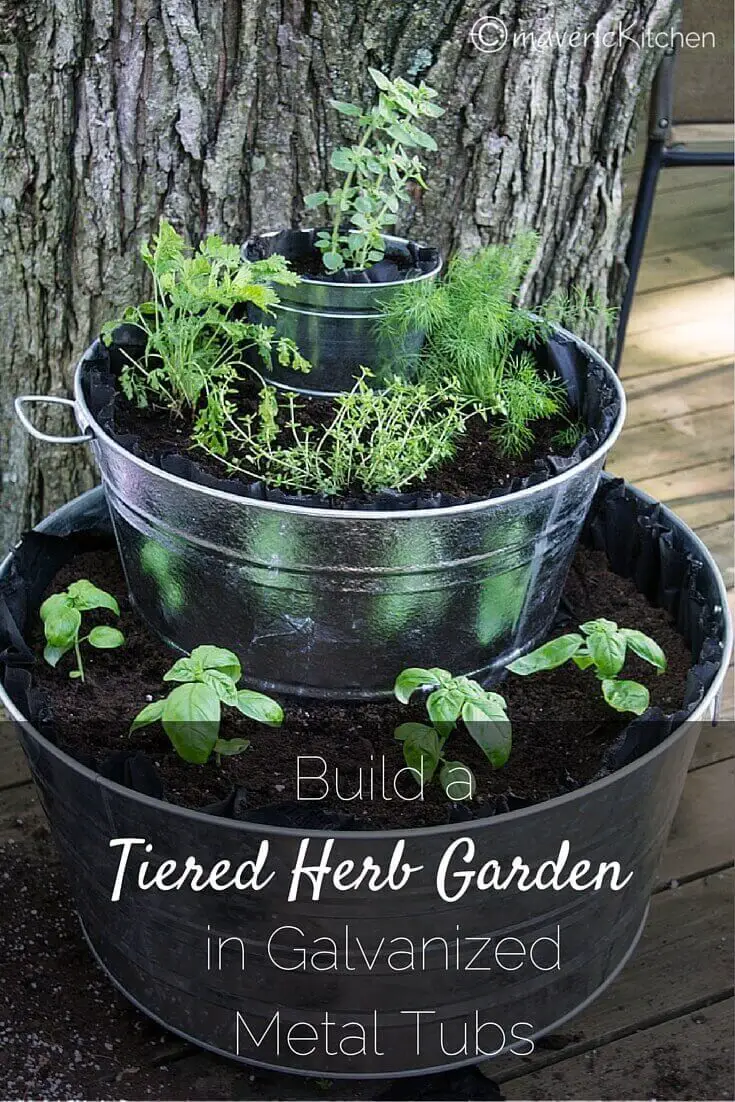
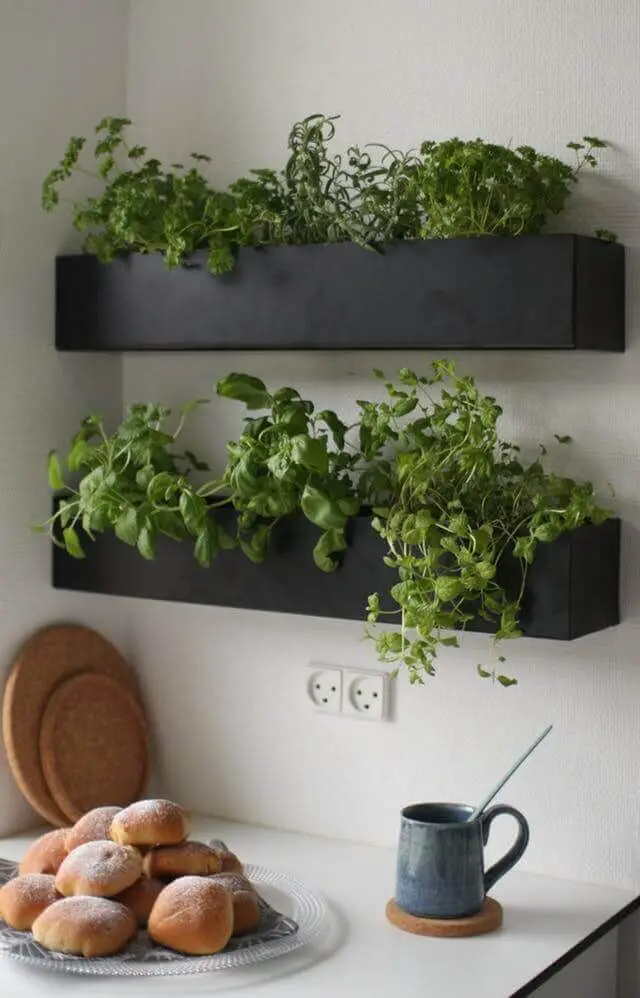
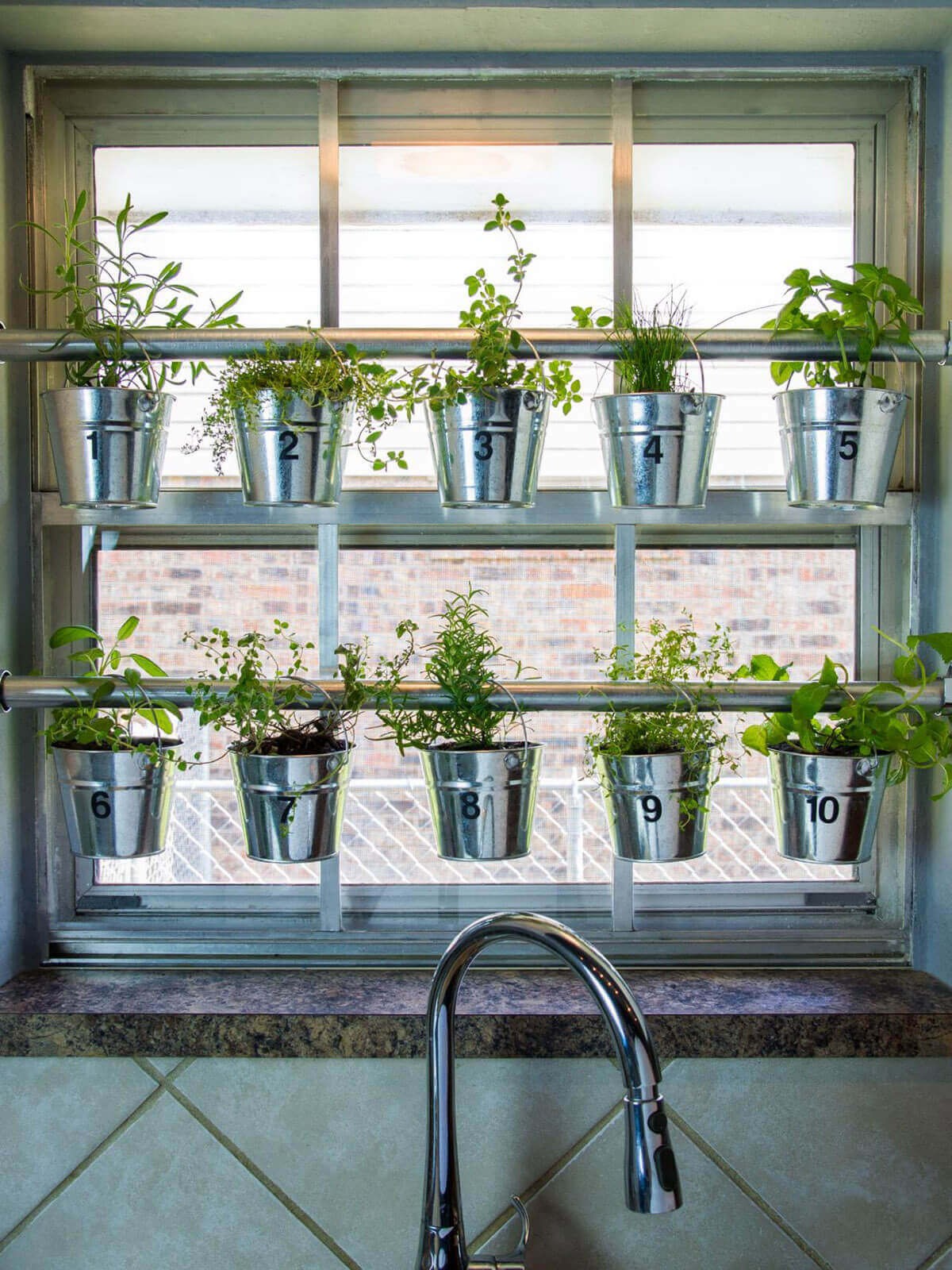
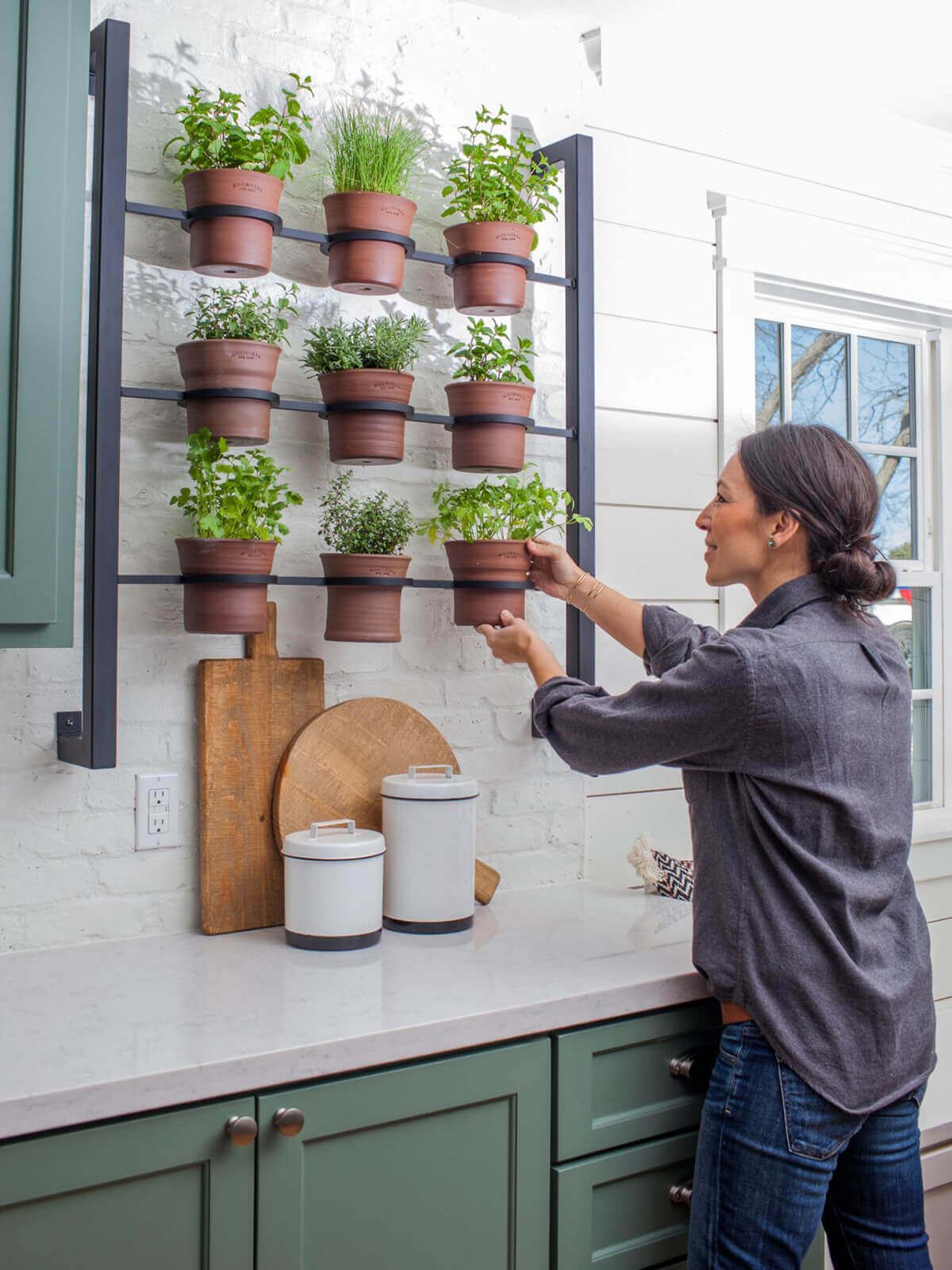
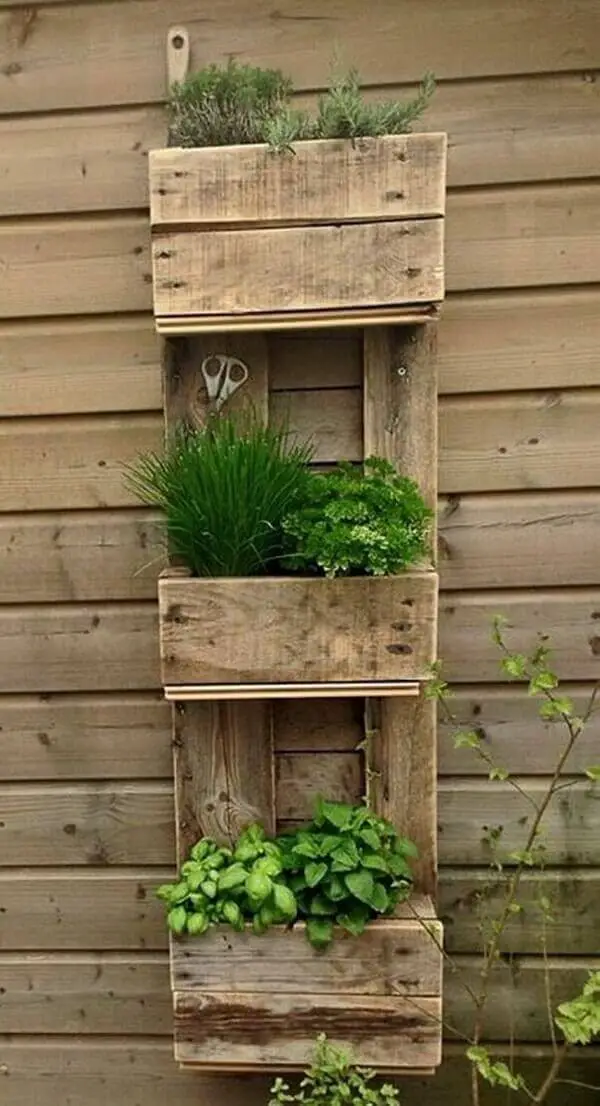
To gather inspiration for our DIY kitchen renovation, we scoured the internet for innovative ideas and stunning designs. From bold colors to clever repurposing of materials, we discovered a plethora of creative solutions to transform our cooking space. We started by exploring the world of social media, where we found incredible resources like Maverick Kitchen’s (@maverickitchen. me) Instagram feed, filled with delectable recipes and mouthwatering kitchen designs.
Next, we delved into the realm of design, visiting websites such as Purple-ID. dk, which showcased Scandinavian-inspired interiors that perfectly blended modernity with tradition. Additionally, we perused popular home decor sites like Hgtv. com, where we found expert advice on creating a warm and inviting atmosphere. Finally, we tapped into Facebook’s vast network, discovering inspiring stories of people who have successfully transformed their own kitchens through DIY projects.
And, to top it all off, we stumbled upon Pallet Wood Projects’ (@palletwoodprojects. com) incredible wooden creations that prove with a little creativity, even the humblest materials can become stunning works of art.
Terraced Herb Garden
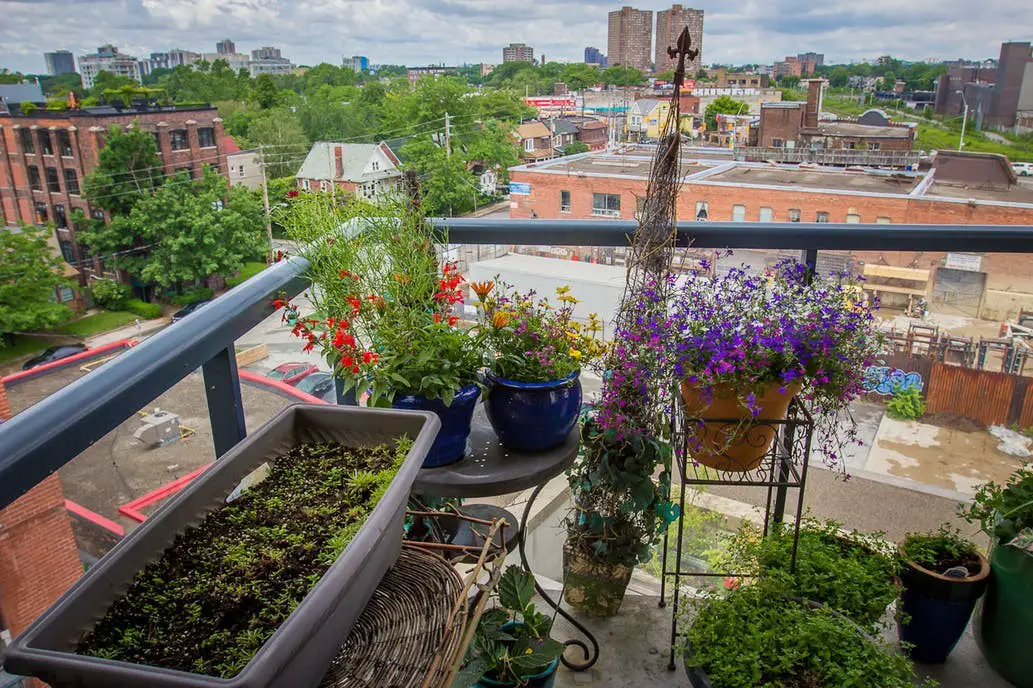
Indoor Hanging Herb Garden
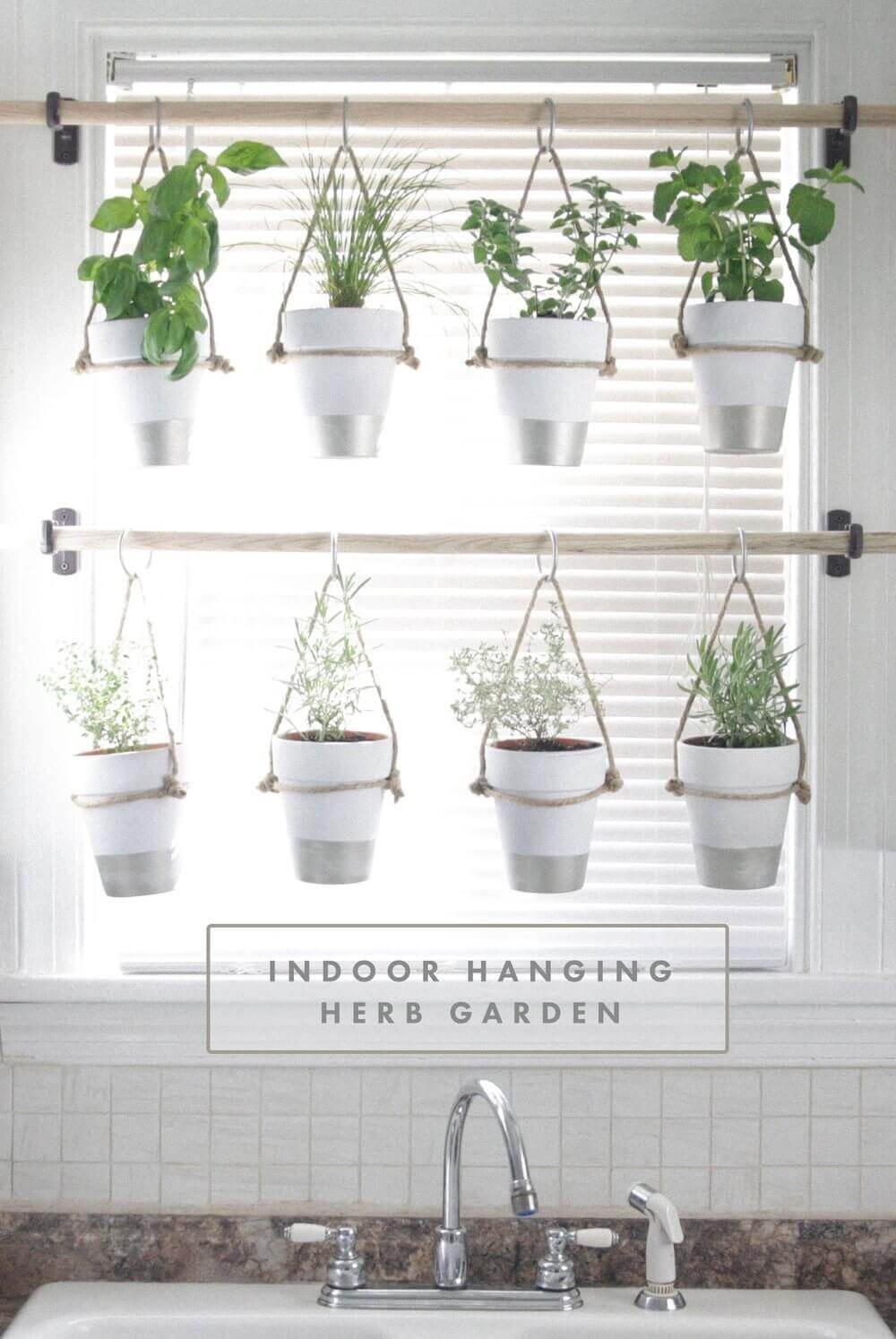
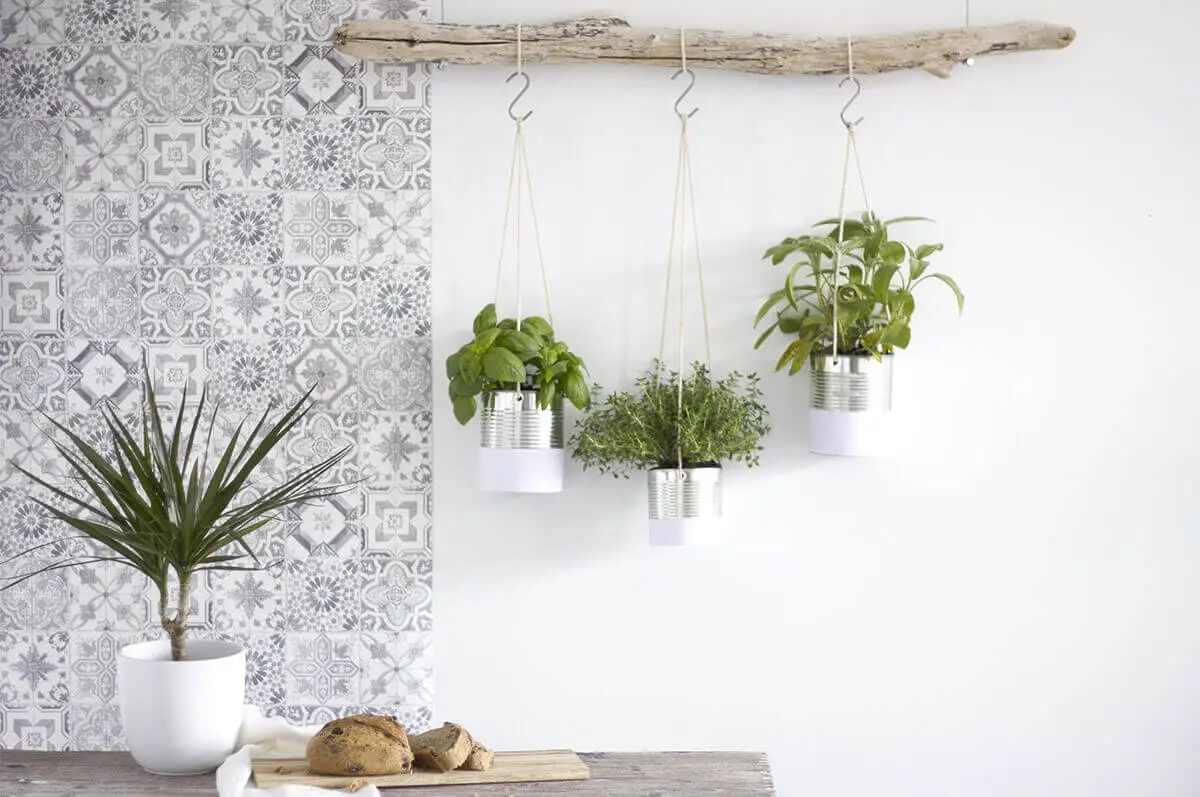
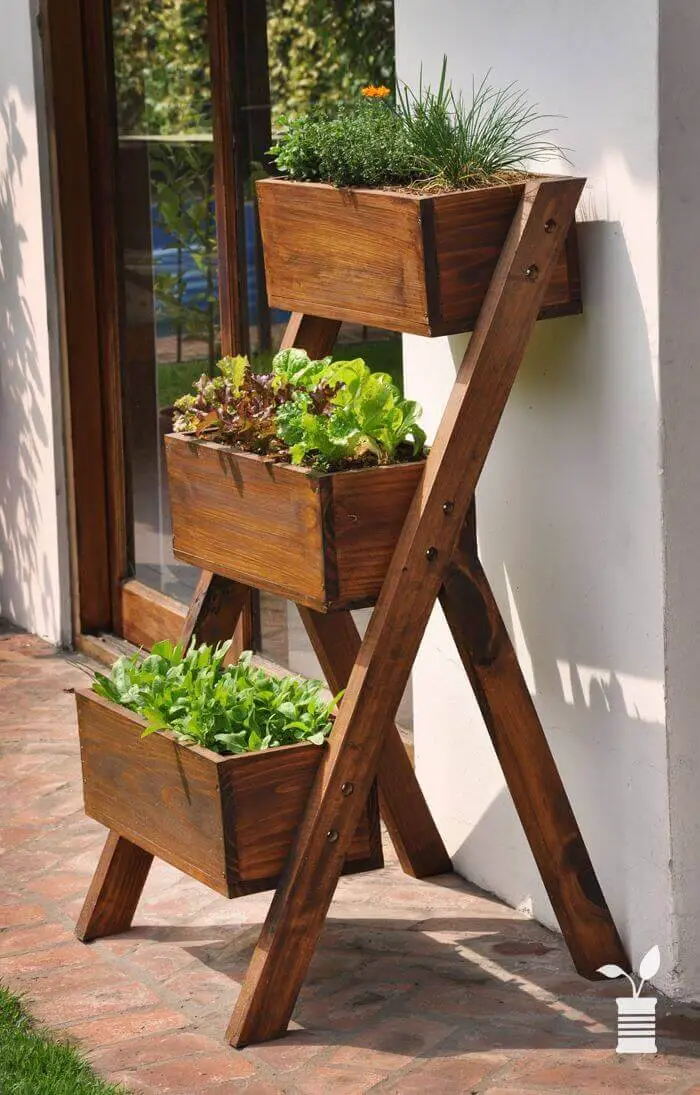
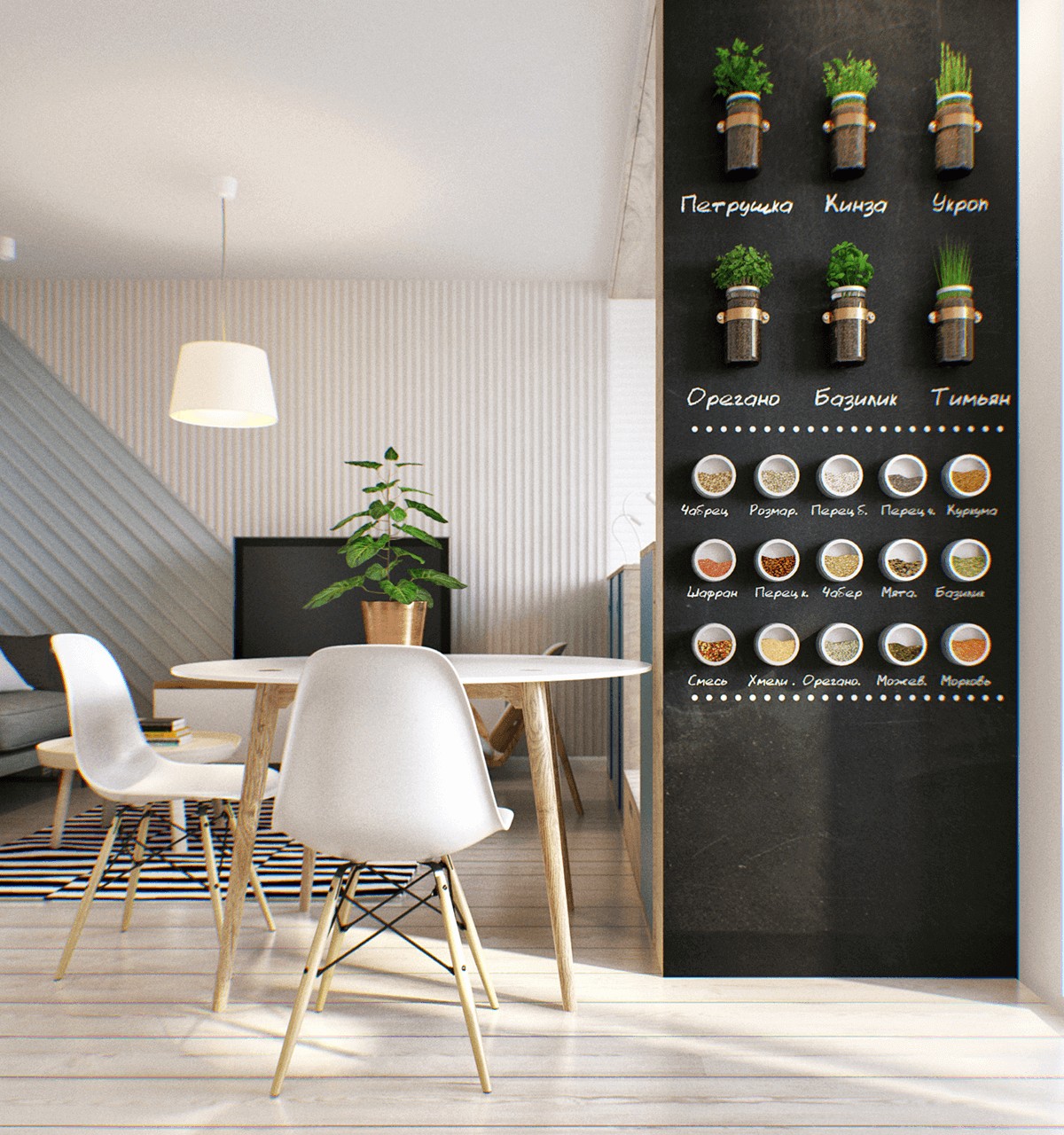
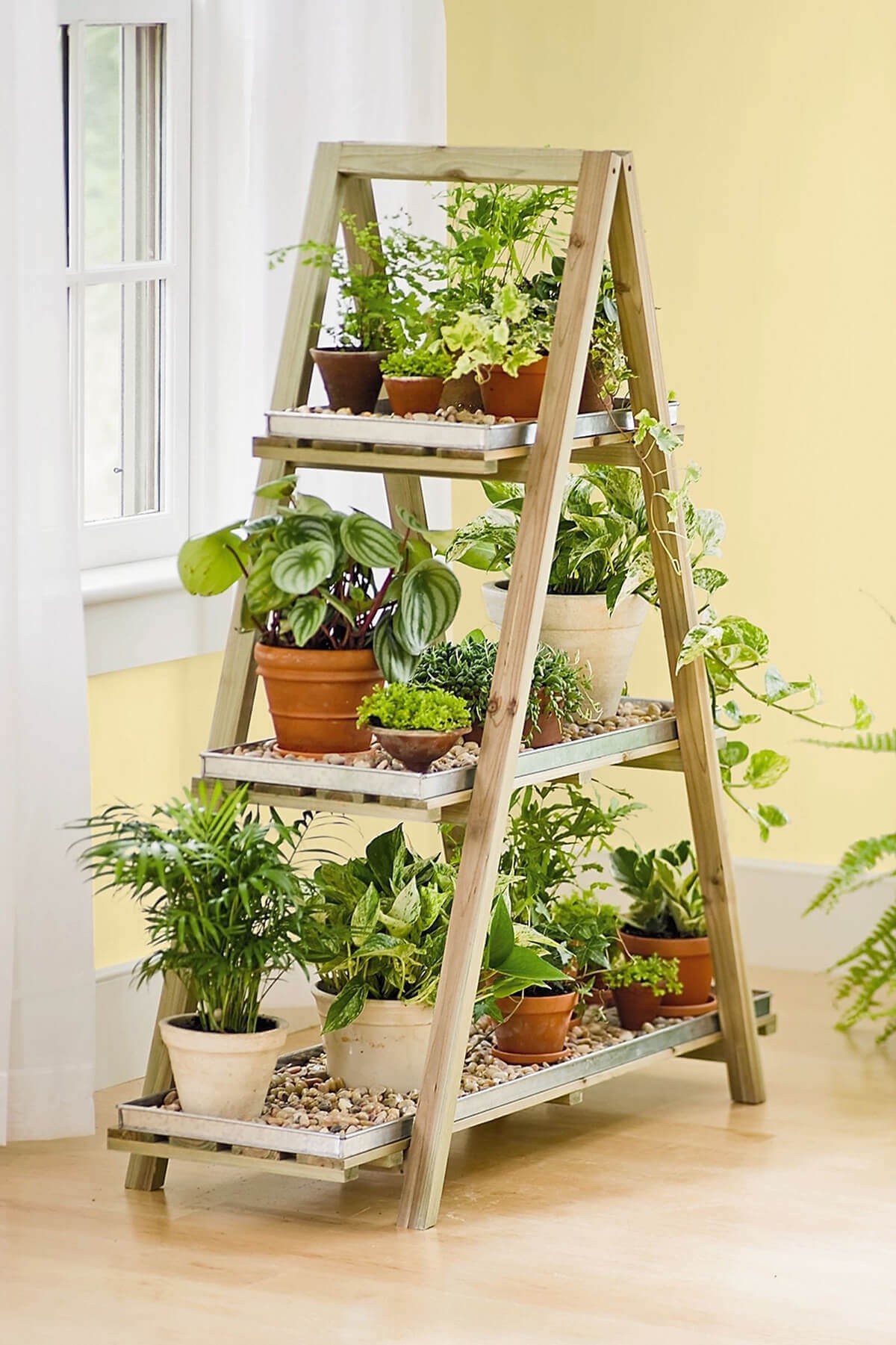
While the internet is vast and full of hidden gems, some websites truly stand out for their unique purpose or design. For instance, The Bird and Her Song (thebirdandhersong. com) offers a delightful fusion of nature-inspired poetry and stunning visuals, creating an immersive experience that transports visitors to a serene world. Similarly, Ladelicateparenthese (ladelicateparentheses.
com) boasts a mesmerizing array of typographical explorations, showcasing the beauty of language through cleverly designed text-based art. On a more whimsical note, Pinterest’s Vietnamese version (hu. pinterest. com) provides an endless supply of inspiration and creativity, as users can discover and share their favorite ideas and projects with ease. In contrast, Thiet Ken Noi That Chung Cuhn (thietkenoithatchungcuhn.
com) takes the concept of a personal homepage to new heights, offering an intimate glimpse into the daily life of its creator through poignant storytelling and evocative imagery. Finally, Craftionary (craftionary. net) is a treasure trove of creative resources, providing an extensive collection of tutorials, templates, and inspiration for crafty enthusiasts to unleash their inner artists. And last but not least, Make It Love It (makeit-loveit.
com) is a vibrant celebration of creativity and self-expression, featuring an array of projects, tips, and ideas that encourage visitors to explore their own artistic potential.
Mason Jar Herb Garden
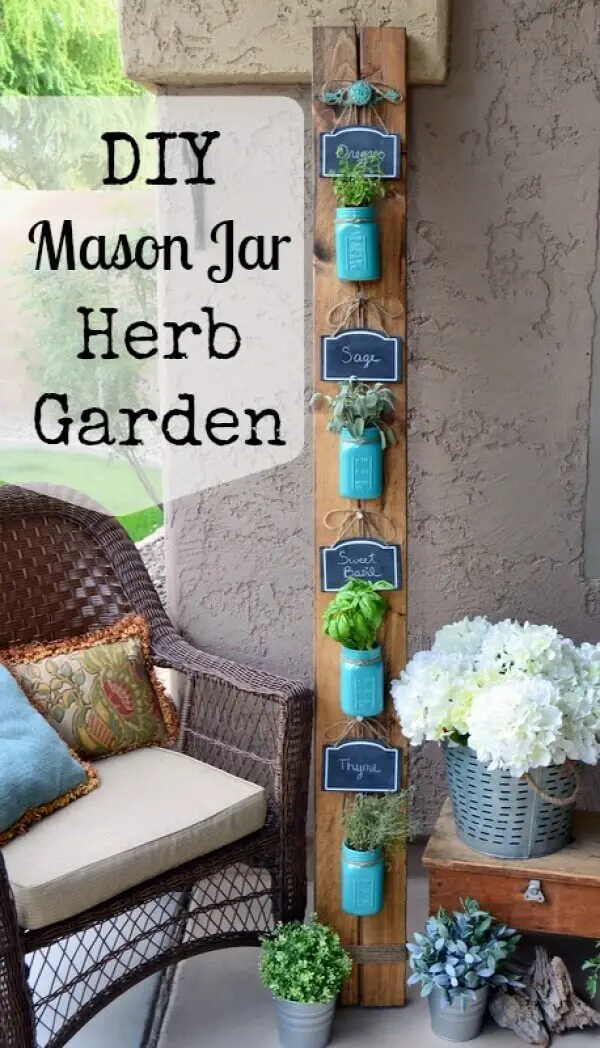
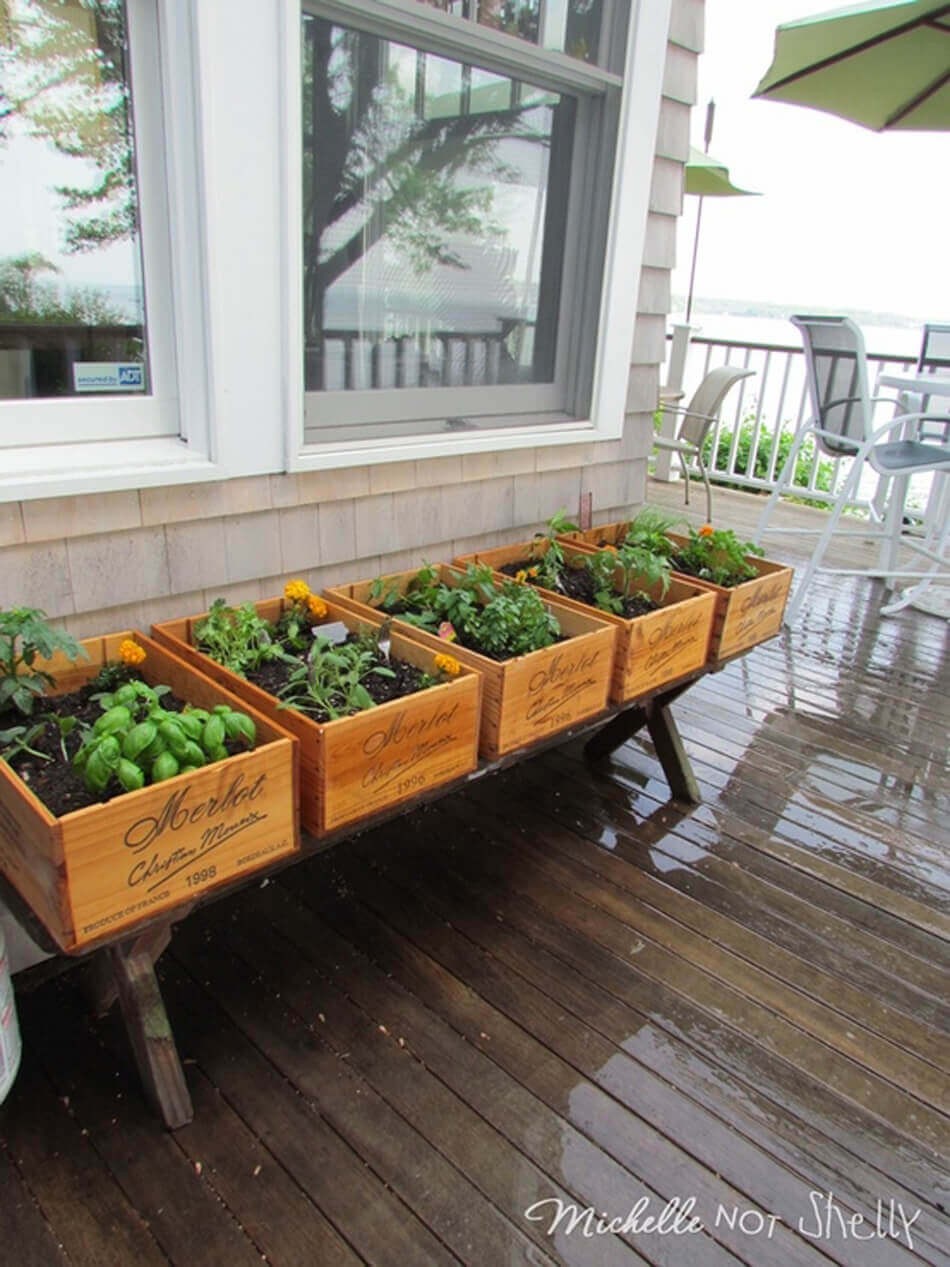

Coffee Tin Can Planters
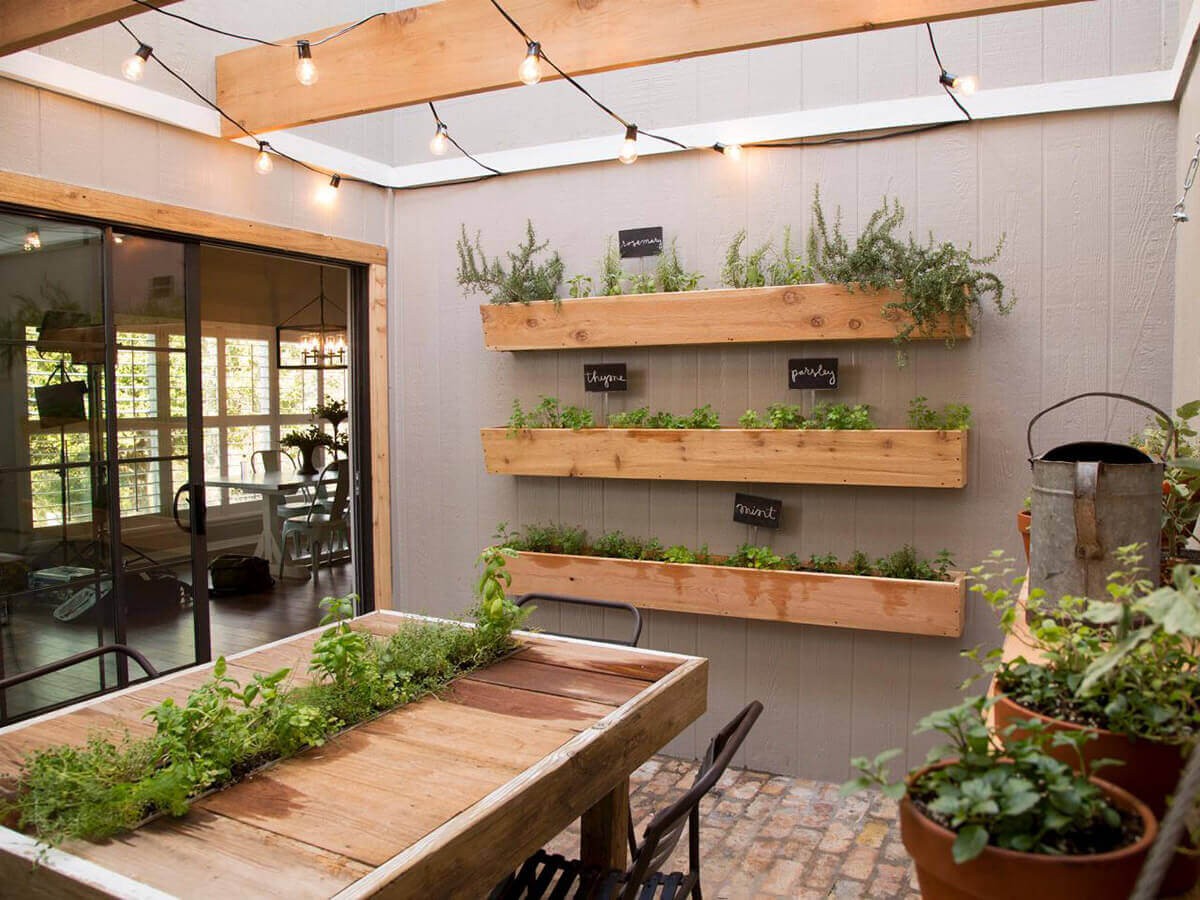
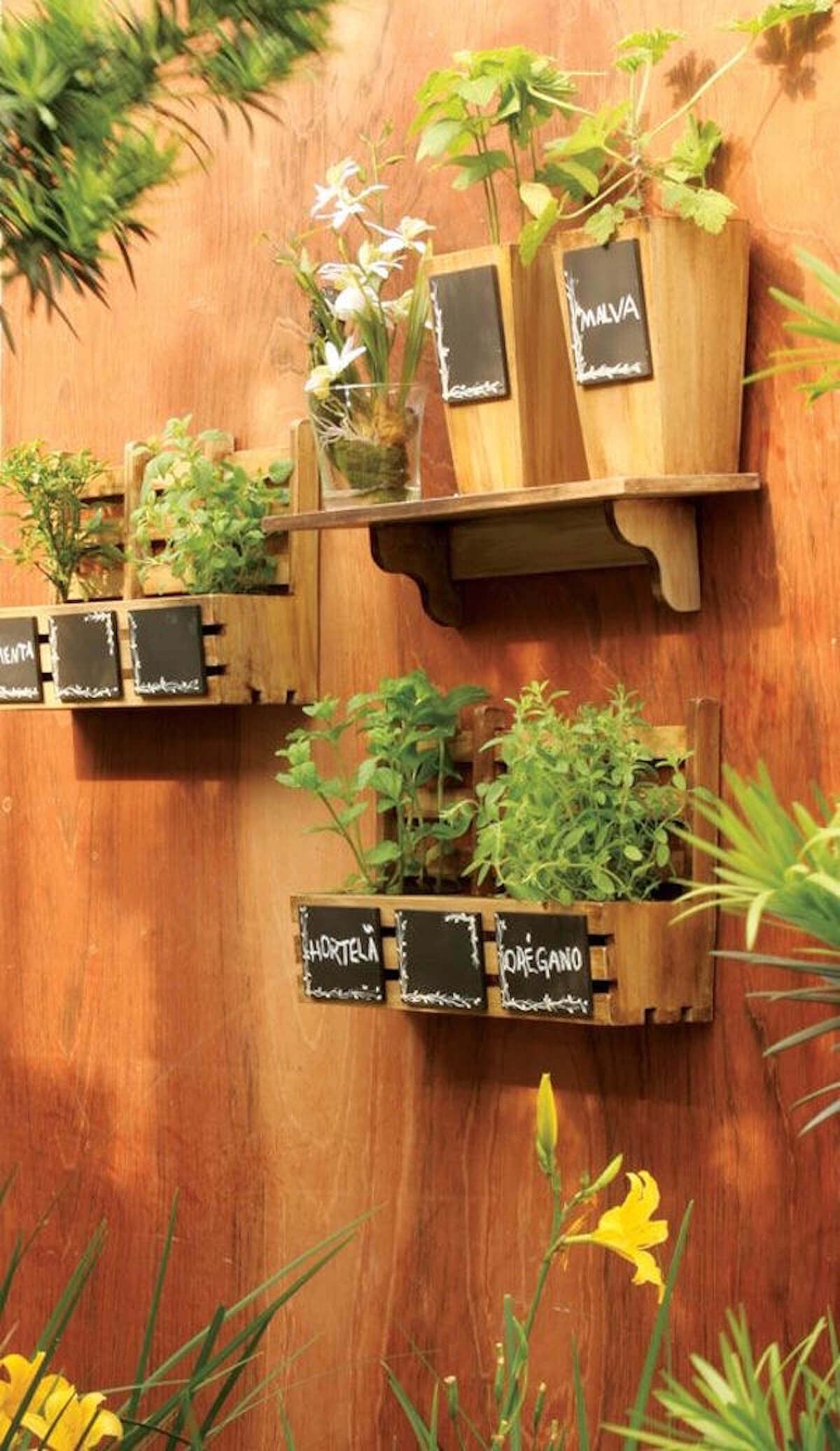
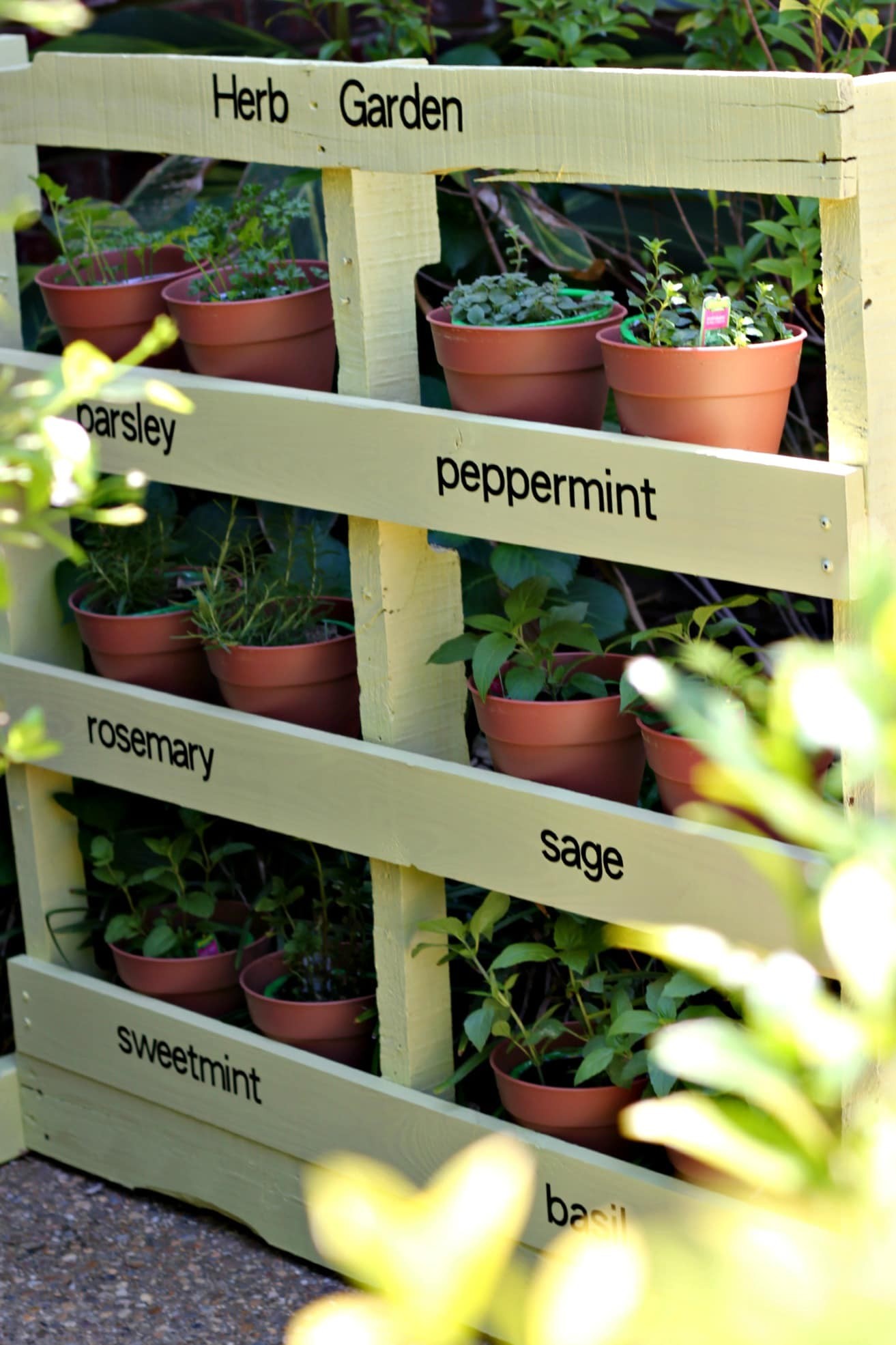
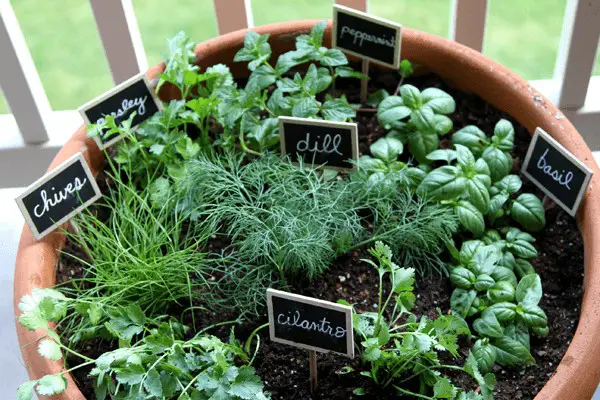

As a homeowner, it’s easy to get stuck in a design rut and struggle to find inspiration for your home’s aesthetic. However, with the abundance of interior design resources available online, there’s no excuse not to stay on top of the latest trends and styles. From home decor blogs like Homeyohmy and Blog Vitrinedeluxo to stunning photography from Hgtv’s photo galleries, there are countless ways to spark your creativity and take your home to the next level.
One popular design inspiration platform is Instagram, where users can follow interior designers, design influencers, and even brands like Rustic and Woven. By scrolling through curated feeds, you can discover fresh color palettes, clever layout ideas, and innovative decor solutions that can be easily applied to your own space. Additionally, websites like Pink When and Black Eiffel offer a wealth of information on home decor, from furniture and accessories to DIY projects and decorating tips.
DIY CLOTHESPIN HERB PLANTERS

COPPER PIPE HANGING PLANTER (CUTE + EASY!)

Indoor Herb Garden IKEA Hack
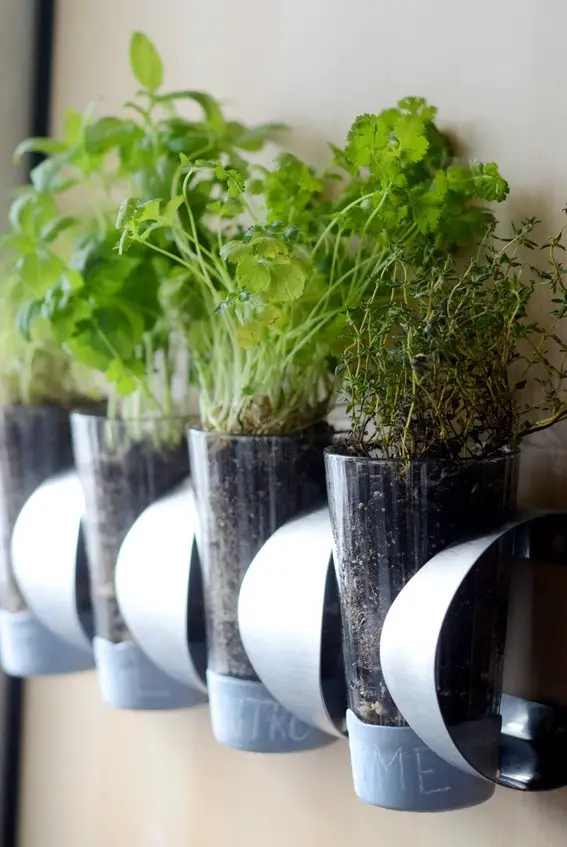
Indoor Window Sill Herb Garden
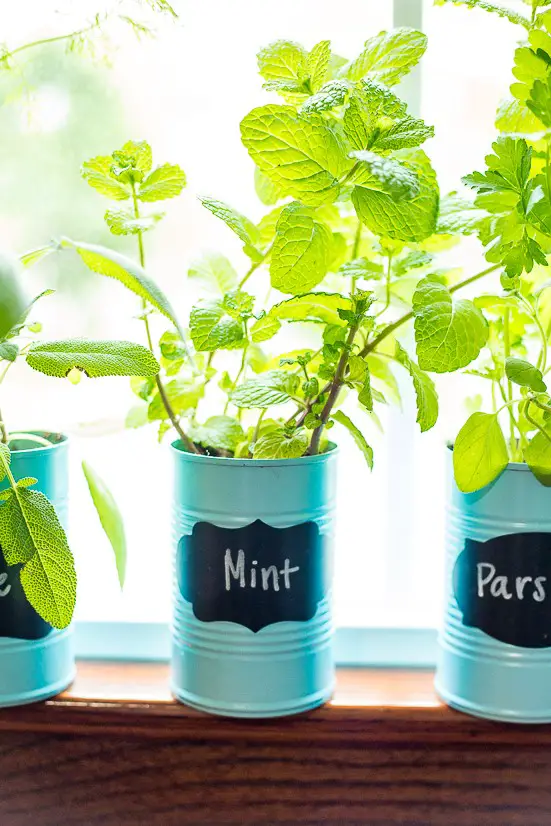
Conclusion
Cultivating herbs at home can be an incredibly rewarding experience, as it not only adds a new dimension of flavor to your cooking but also provides a sense of pride and accomplishment. The process itself is straightforward and cost-effective, making it accessible to anyone looking to elevate their culinary game. We invite you to share your thoughts on this topic by leaving a comment below – which herb-growing techniques or ideas have resonated with you the most?


